|

26 January
1973 - Ten Years After at
Concertgebouw Amsterdam
Photographer:
Gijsbert Hanekroot Website:
https://gijsberthanekroot.com/
- Licence from
Alamy -

January 1973
- POP Magazine, published as Big Size Poster,
Germany and Switzerland
|
Circus Magazine January 1973
$ . 75
Cents


 |

Alvin Lee:
Ever
since the film “Woodstock,” showed Alvin’s blonde
hair flying and his fingers sailing over the guitar
strings, he’s been trying to shatter the notion that
he’s a superhuman sex symbol. |
It’s an unseasonably muggy Sunday night and Ten Years After are
headlining at New York’s grimy old Academy of Music. The
midnight set has just gone into it’s second encore and
there are still cries from the crowd for “More” ! Lead
guitarist Alvin Lee whispers to his sweat-soaked cohorts
in the wings, “let’s give em´ a quick one”. They take
the stage again to thunderous applause, and tear into
“Johnny B. Goode” but drummer Ric Lee has taken Alvin a
bit too literally and rushes the beat; so they suddenly
stop short, count off and start the song again. This
time it’s right, the music keeps getting louder and
faster while shouts out verses of “Rip It Up” and
“Tutti-Frutti” and finally rips off a frenzied guitar
solo that leaves literally nothing else to play. Even
the jaded backstage denizens are clapping as the band
finally stumbles offstage and the house lights go up.
This is a strange way indeed for a full-fledged rock
star to behave. Less than two weeks earlier, in a
theatre only a few scant miles away, David Bowie, the
new glamour rock’s prettiest star, danced with
unfaltering precision through a tightly choreographed
set of songs despite a bass amplifier that resolutely
refused to function properly, keeping his show moving
even though the sound was going nowhere.
Kicking Solid
Gold In The Teeth:
In this musical
season of Bowie and Bolan, when even Mick Jagger has
taken to wearing eye glitter and purple body stockings, Ten Years After has thrown a strange new twist into its six-year war
against superstar flash. Ever since they got together in
1967 they’ve gone onstage in their rock `n´ roll jeans,
playing to please no one but themselves, and bringing
audiences more accustomed to slumping in their seats to
their cheering, stomping feet.
But in the last
few weeks, they’ve taken their rebellion against
superstar glamour a step further with their new album,
“Rock & Roll Music To The World” (On Columbia Records),
an LP that deliberately tosses away the formula that
only ten months back earned the group its first
million-selling LP in over half a decade of patient
music making. Less than a year ago the song “I’d Love To
Change The World” with its lush, infectious acoustic
guitar runs, astonished Ten Years After followers by
climbing to the pop fifty on the charts. Then came
something even more surprising. After five non-gold LP’s
A Space In Time. The very
un – Ten Years
After – ish LP which “Change The World” had come from,
not only turned gold, but stayed on the charts for
nearly half a year, rivalling even the longevity of that
season’s latest posthumous Hendrix release, “Rainbow
Bridge”. But did Alvin Lee stick to the musical formula
that had suddenly launched him into the skies of solid
gold? Not by a long shot. In a puzzling reversal, he has
abruptly snapped away from the carefully structured
flash and glitter that made “A Space In Time” his most
commercially successful work to date, and taken “Rock &
Roll Music To The World”, back to the sound of his
previous six albums.
The funky,
rocking blues the group likes best. Alvin explains,
“This album isn’t the songs I write for the group. I
didn’t construct anything. All the songs just came off
my head and we all played what came out is just the
natural music of the band”.
Just Another
T.V. Hater:
While “I’d Love
To Change The World” the top 50 single from the last
album, catalogued the horrors of war and pollution to a
melancholy acoustic guitar backing, the new album sets
its mood in the hard-charging title cut: “Ain’t no
relation to the United Nations – I just shout and do the
rest with my guitar – Give peace a chance, get up and
dance – I’m singing rock & roll music to the world.
“Turned Off T.V.
Blues” stabs a pin into the gilded dream of rock star
glamour to show just another bored human being sitting
in a hotel room with nothing to do but gaze blankly at a 21- inch screen:
(Lyrics) – I’m sitting here in oblivion, what a great
night to watch T.V.
It just fills my
mind with garbage, that my eyes ain’t supposed to see.
Watching T.V. is a real energy drain,” Alvin says,
stretching his long legs in the back of the sleek black
limousine taking him down to the Academy of Music. “I’d
sit down to watch something and before I knew it, four
or five hours would be gone and I’d have done absolutely
nothing creative.
The songs just
grew out of my reaction to that whole trip, in all its
drab and universal humanity, is what Alvin Lee would
like the world to know he’s all about.
Cool The Hot
Pants:
From the very
beginning Ten Years After have been a group who couldn’t
care less about six-inch silver
boots, strobe lights, hot pants, dyed hair and mascara.
They emerged from the grimy British industrial town of
Nottingham during the British Blues Explosion that also
launched such groups as Cream and Fleetwood Mac, after
an extended residency at London’s famed Marquee Club.
They cut their first album, which was about equally
divided between their own songs and well-known blues
such as “Help Me Baby” and “I Can’t Keep From Crying
Sometimes” (Still one of their most popular on-stage
numbers today), that fall, and followed it up with an
excellent live album, appropriately titled “Undead”,
that featured an extended workout on Woody Herman’s big
band hit of the 1940’s “Woodchoppers Ball”.
“We did “Undead”
in this tiny club right next door to Decca recording
studios,” Alvin recalls. “We just ran the wires over the
roof and put the mikes through the club window, while
Mike Vernon, our producer, sat in the studio mixing it
right off the line, which was pretty handy.
It was rude and
crude, all done in one night with no retakes or overdubs
to cover the rough parts”.
Reluctant Sex –
Symbol:
But once the
first flush of success had established Ten Years After
as a well known, working band, Alvin took over as the
group’s undisputed leader and chief songwriter, and
that’s when Ten Years After’s problem with Alvin Lee’s
image as a sex-symbol and superstar reared its
unexpected head. Their third album, “Stonedhenge”,
reflected Alvin’s growing interest in electronic music
and attempted to break away from their image as a blues
band.
With their
fourth album, “SSSh”, Alvin took over as the group’s
producer as well as songwriter. Unfortunately, the
album’s best cut was the only non-Lee composition, “Good Morning
Little School Girl”. The groups last album for Deram,
“Watt”, went to far as to picture, on the inside cover,
Alvin sitting at the studio engineer’s console mixing
the album while the rest of the group looked on from
behind a glass partition. Alvin had inadvertently taken
the first step toward becoming Ten Years After’s mini
Jagger.

Alvin
Lee, guitar:
Upstairs in the New York's Academy of Music dressing
room there were groupies, food and wine enough for
everyone. But Alvin Lee just sat down on a couch and
explained why, on his new LP “Rock and Roll Music To The
World” he completely abandoned the sound that last year
won him his first gold LP.
Blonde Hair and
Flying Fingers:

Then came
Woodstock and the movie that followed. The film featured
Ten Years After’s Rave – Up encore
of “I’m Going Home,” but the camera ignored the rest of
the group and focused on Alvin’s frantically waving
blonde hair, flying fingers and screaming lips as if he
were the only musician on the stage. The movie elevated
the festival to a legend, and carried Alvin Lee along
with it, but Ten Years After was apparently being left
behind.
Alvin tried to
stop his on-rushing superstar image in its tracks with
“A Space In Time”. He explains that
“It was the culmination of all our experiments. We’d
gotten tagged as a heavy rock and roll band because of
the whole Woodstock thing, so for that album I wrote
some more structured numbers. I’d been listening to Van
Morrison and James Taylor and some of that feeling got
into my music”. But, Alvin’s Space In Time experiment
backfired.
It was the
group’s most successful album commercially, giving them
their first single, that even Top Forty Stations would
play, and their first gold LP; but just like their
exposure in Woodstock, it presented them with a danger
they loathed – the risk of attracting hordes of kids to
their concerts who would be more interested in screaming
than in listening to the music.
Back To Blue
Jeans:
So, while most groups once they find a hit-producing
formula, they stay with it. Ten Years After turned away
from the softer, more complex sounds of “Space In Time”,
to return to the straight – ahead – blues and jazz that
originally inspired them. “In our early days, before we
recorded, we used to get thrown out of clubs for playing
blues, because people couldn’t dance to it, so we used
to play what the people wanted to hear. But we’ve always
liked blues and jazz best. We proved, with “Space In
Time”, that there was another side to us than “I’m Going
Home”, and that sort of music”. A year ago Alvin Lee sat
in a darkened room grumbling to a writer from a British
photographic magazine about how a series of moody,
pin-up like album covers had made him the hard-rock
David Cassidy. Then, as if to show he was a musician,
not a beauty queen, he boasted with quiet pride, “We’ve
never had a gold record, you know”. Now it almost seems
as if Alvin wishes that were still the case.
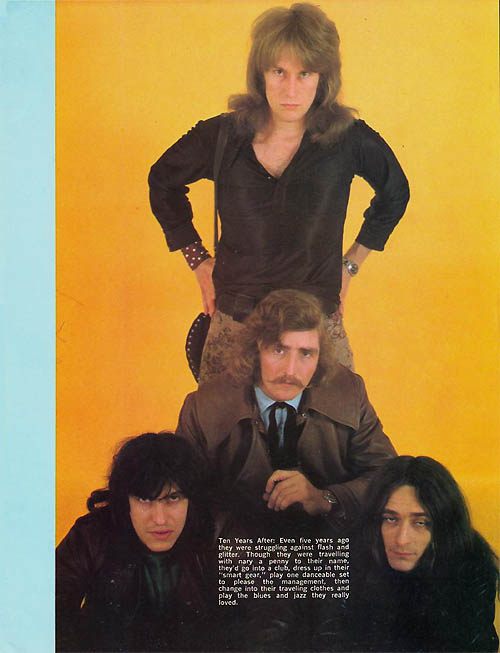
 |
BRAVO Magazine,
Germany



 Rolling Stone Magazine 2/ 1/ 73
Rolling Stone Magazine 2/ 1/ 73
Group Gropes:
Ten Years After’s Bout With Image
Los Angeles - It’s almost Twenty Years After, if you believe the
story that Alvin Lee turned pro ten years after Elvis
Presley’s English invasion of 1954, but Ten Years After are
still struggling with their image. Ever since Woodstock has
dragged around the “Going Home” albatross, a “boogie,
get – yer rocks- off number” that imprisoned them
in the Grand
Funk category, had them setting off riots in LA and finally
drove them into a three month rest-retreat in
an effort to escape.
“Part
of it was my fault” says Lee, “When I first came over to
the states I was very headstrong and I thought interviews,
radio and anything other than playing was just hype. So I
didn’t do any interviews for a long, long while. Then all
sorts of stories
built
up –about me and the band and everything else, so I figured
it was just due to lack of communication on my part.
LA
always tends to be a little more freaked out than the other
places. I remember the first Forum concert we played, the cops
were hitting people with sticks on the front row; we ended up
just walking out halfway through our number, and
as
far as I know, nobody particularly noticed, they all applauded
at the end of the half number and thought that was it. I just
felt really sick; I couldn’t get high with that going on.”
Recently,
in front of an L.A. Forum audience disposed towards chaos
after an hour’s equipment delay,
Ten
Years After was marvellously
unaffected, making no effort to incite the crowd beyond
the energy
of
the music itself. Instead of the classic glowering, menacing
British blues band demeanour , TYA just laid back and
played music. To
some degree, of course, the stage antics remain. “I think
it’s called histrionics isn’t it?” said bassist Leo
Lyons playfully.
But,
overall the actions remain natural, something they just feel
like doing. “It’s not forced in any direction”, says
Alvin.
“and
it’s not meant as phallicism, it’s meant as a bottleneck
with the mike-stand.” Throngs
of gasping young ladies might dispute the claim, but Alvin
insists that he avoids the superstar role as much
as possible. “I think it affects Alvin more than it does us”
said Lyons, “because his face was on Woodstock more than
anyone
else’s. I think it’s the cause of all this knocking.
We’ve probably had the worst press that anybody’s ever
had. To a certain extent, Woodstock set him up as a figure
larger than life, and people are gonna come along
and
want to knock him down, see if he really can walk on water.”
 Alvin,
a filmmaker of sorts himself (“It’s a side trip”)
complains that Woodstock took “Going Home” out of context
and
set them up cinematically as something they are not. “It
represented part of us, but that part was put out of
proportion
to
the other parts. It brought us to the attention of a wider
audience; however, that wider audience wasn’t particularly
the
right thing for the concerts. The whole FM, underground
feeling is one I’ve always been happy with. To play to the
minority
audience, to me is better than playing to a mass audience that
just came for the event. But we started
getting
that kind of audience, little 13-year old screamers and
gigglers and people pulling your shoes, which wasn’t helping
us
do what we wanted to do—to turn on people with our music.”
A three-month, self-evaluating layoff
before the Space In Time album seems to have exorcised
some of those elements. Alvin,
a filmmaker of sorts himself (“It’s a side trip”)
complains that Woodstock took “Going Home” out of context
and
set them up cinematically as something they are not. “It
represented part of us, but that part was put out of
proportion
to
the other parts. It brought us to the attention of a wider
audience; however, that wider audience wasn’t particularly
the
right thing for the concerts. The whole FM, underground
feeling is one I’ve always been happy with. To play to the
minority
audience, to me is better than playing to a mass audience that
just came for the event. But we started
getting
that kind of audience, little 13-year old screamers and
gigglers and people pulling your shoes, which wasn’t helping
us
do what we wanted to do—to turn on people with our music.”
A three-month, self-evaluating layoff
before the Space In Time album seems to have exorcised
some of those elements.
“We’re
all equal members of the band” said Alvin “We all get paid
the same; we all work the same. I personally
don’t
think a band’s structure should have a leader and the rest
of the musicians just a backup band. When people started to
say “Alvin Lee and Ten Years After’ that caused some alarm
to me as well. At first I ignored it, but it didn’t go away,
so
we sat down and talked about it and we got it together.”
To
look at the band, it would be only logical to assume that
Alvin is the leader; lead singer, lead guitarist, he writes
all
the
material and stands center
stage as well. But, he explained, “It isn’t my music,
it’s the music of the band. Four heads
make
up that music. I just write basic structures which the band  develops by jamming.”
develops by jamming.”
The
other band members, Lyons, organist Chick Churchill and
drummer Ric Lee (no relation) agree that they are a cohesive
unit, not a backup band, but concede that Alvin still gets the
most attention.
Among
the band, Alvin and Leo Lyons are the closest, having been
together since they were 15. Leo dresses like a cowboy, but
says, “In a way I’d be ashamed of calling myself a cowboy
after reading what a so-called civilized nation did to
the
Indians. So I’m an Indian.”
That
story about Ten Years After and Elvis Presley provided some
nice tie-ins about the influence of rock & roll
on
the band, but, unfortunately, was quite fictional. They just
needed a catchy name and Leo dug one up out of
the radio program
listings: Ten Years After was almost Life Without Mother.
Alvin now says, “If it meant anything at
all, it meant ten years after now, not necessarily futuristic
, but it had that connotation. It was a kind of
surrealistic
feel, and it was nice. Blues
was as much an influence as rock & roll and though Lyons
will sportingly try to make a case that blues is a British
form (since it was originally African and the British were
instrumental in enslaving the Africans) both admit in
serious
moments that musically they feel more American than British.
“My
father”, said Alvin “used to collect early American blues.
My brother in-law used to listen to all the big swing bands.
When,
in England there was a blues boom, I found myself, without
having to think, really knowledgeable
on
blues because of my father’s collection and his interest in
it and I read quite a few books on it as well and it kind of
gave me a confident edge.”
That
edge was bolstered by his family’s illustrious career in
country music.
“About
once a year they’d do a local gig—“Home on the Range”
with cowboy hats on. They were interested and
involved
in music; they weren’t tremendously active. There was always
a guitar around the house. They encouraged me
to take up an instrument seriously. I was 12 when I first took
up the clarinet, which didn’t lead me anywhere.
It
was like a chore.  “Through
playing the clarinet I listened to Benny Goodman a lot. With
Benny Goodman was Charlie Christian
one
of the pioneers of the electric guitar. I got turned on to him,
really…and when I started the guitar lessons, my
guitar teacher was a Django Reinhardt fan and all he actually
taught me to play was the kind of chording
Django plays, those really vamping chords. I got off on hearing
somebody with the technical skill to play whatever they
want. In fact, for a long while, if I heard somebody play a
piece that was really hard to play, I got off more on that
than
the melody. The melody side of things came later, like the
Beatles. His
admiration for technical skill has brought Alvin cartloads of
criticism for flashiness. “It kind of gets lodged
In
the back of the head somewhere, particularly the speed thing
where everybody was saying “ The Fastest Guitarist in the
West---so what?’ I just had a fast style.
“When
I got aware of this kind of buzz going on I subconsciously at
first wanted to show that I could be more
structured
and I wasn’t all just speed,
which I wasn’t. I knew that, but I wanted to point it
out to the people that didn’t, which
I think is a mistake. You’re always gonna get knocked and
you’re always gonna get praised and neither one
is
healthy to take seriously.” “Through
playing the clarinet I listened to Benny Goodman a lot. With
Benny Goodman was Charlie Christian
one
of the pioneers of the electric guitar. I got turned on to him,
really…and when I started the guitar lessons, my
guitar teacher was a Django Reinhardt fan and all he actually
taught me to play was the kind of chording
Django plays, those really vamping chords. I got off on hearing
somebody with the technical skill to play whatever they
want. In fact, for a long while, if I heard somebody play a
piece that was really hard to play, I got off more on that
than
the melody. The melody side of things came later, like the
Beatles. His
admiration for technical skill has brought Alvin cartloads of
criticism for flashiness. “It kind of gets lodged
In
the back of the head somewhere, particularly the speed thing
where everybody was saying “ The Fastest Guitarist in the
West---so what?’ I just had a fast style.
“When
I got aware of this kind of buzz going on I subconsciously at
first wanted to show that I could be more
structured
and I wasn’t all just speed,
which I wasn’t. I knew that, but I wanted to point it
out to the people that didn’t, which
I think is a mistake. You’re always gonna get knocked and
you’re always gonna get praised and neither one
is
healthy to take seriously.”
But
anyone who criticizes Alvin Lee for being the stereotypical
arrogant kid guitarist has obviously never met him, at least
recently.
“The only thing I think about myself,” he said, “is that
I am doing something original. I am following
my
own path. I’m not a great innovator, but I try and do my
best. I’m doing something which is coming
from inside of me.”
By
Paul Bernstein
|
January 1973 - Beat
Instrumental


POP Magazine, No. 2 - January 1973
 POP Magazine - January 1973



|
POP Magazine
January 1973 - Part One
Ten Years
After – Alvin Lee Superstar
Es gibt zweierlei Arten von
Rockgruppen. Auf der einen Seite stehen die
Formationen, die im Kollektiv auf das Publikum wirken,
bei denen sich jeder einzelne Musiker ein Stück vom
Erfolgskuchen abschneidet, jeder seine Fans hat. Dazu
gehören die Rolling Stones,
Led Zeppelin oder Slade. Und dann
gibt es jene Gruppen, deren Ruhm sich auf einen aus
ihrer Mitte stützt. Gruppen, in denen es einen großen
Superstar gibt und in denen die restlichen Musiker,
wenigstens in den Augen des Normalkonsumenten, als
bloße Statisten fungieren. Typische Vertreter dieser
Art von Gruppenbild sind Marc Bolan und seine T. Rex –
oder eben die Ten Years After des Alvin Lee. Würde vor
einem Ten-Years-After-Konzert unter den wartenden
Zuschauern eine Unfrage starten und die Leute nach dem
Grund ihres Kommens fragen, würde die Antwort in neun
von zehn Fällen lauten : Um Alvin Lee zu sehen. Denn
Alvin Lee ist – vor allem für die ganz junge
Generation der ungekrönte Speed-King, der Gitarrenheld
schlechthin. Viele seiner Gegner sagen zwar, dass er
außer seinen schnellen Fingern nicht viel mehr zu
bieten habe; feeling sei ein Fremdwort für ihn.
Nun-egal, was man von Superstars im allgemeinen oder
von den Qualitäten des Mr. Lee im speziellen hält.
Unbestrittene Tatsache ist, dass
Ten Years After seit langen fünf Jahren zu den
beständigsten und beliebtesten Rockformationen der
Welt gehören. Und dies haben sie wohl nicht zuletzt
ihrem Superstar Alvin Lee zu verdanken.
|

Interview with Alvin Lee: "I am not Ten Years
After" To read article click
left and right areas to enlarge |
POP
Magazine January 1973 - Part Two
Interview Mit Alvin Lee – „Ich
bin nicht Ten Years After“
POP: Was hat Woodstock für Euch
bedeutet?
ALVIN LEE:
Woodstock brachte uns
in erster Linie Erfolg und Zufriedenheit. Und
natürlich einen weltweiten guten Ruf. Erst später ist
der Gruppe dieser sogenannte gute Ruf beinahe zum
Verhängnis geworden. Die Leute wollten immer wieder
unseren Woodstock Song „I’m Going
Home“ hören. Sie erwarteten von uns Rock `n´
Roll und immer wieder Rock `n ´
Roll. Natürlich spielen wir gerne Rock `n
´Roll, aber es gibt so und so viele Musikarten, für
die wir uns ebenso interessieren.
POP: Trotzdem war Euer letztes
Album eine reine Rock-Angelegenheit.
ALVIN LEE: Stimmt. Wir wollten
eine LP rausbringen, die die Art von Musik
enthält, die das Publikum immer wieder
bei unseren Live-Auftritten verlangt. In vielen
Ländern war „Rock `n ´Roll Music“ ein voller Erfolg.
Seltsamerweise ist aber die LP weder in England noch
in den U.S.A. sehr weit nach oben gekommen.
POP: Ihr arbeitet nicht mehr so
hart wie früher. Warum?
ALVIN LEE: Wir können heute
sicher sein, dass Ten Years After eine vollkommen
etablierte Sache sind. Deshalb hat es keinen großen
Sinn, sich unnötigerweise zu überarbeiten. Es kann
sogar vorkommen, dass die Musik unter zu großem
Arbeitsanfall Schaden nimmt.
POP: Möchtet ihr auch andere
Stilrichtungen als Rock `n ´ Roll auf Platten bringen?
ALVIN LEE: Aber sicher. Es haben
sich innerhalb der Gruppe verschiedene Ideen
herangebildet, die wir unbedingt verwirklichen
möchten. Es stimmt zwar, dass ich das meiste Material
geschrieben habe, das dann auf die Platte kommt.
Trotzdem möchte ich betonen, dass ich mich nicht auf
einem Egotrip befinde und sehr daran interessiert bin,
dass auch meine Mitmusiker etwas vom Scheinwerferlicht
abbekommen. Ich war sehr verärgert, als unsere
ehemalige Plattenfirma alte Nummern unter dem Titel
„Alvin Lee & Co.“ auf den Markt brachte. Ich
muss immer wieder betonen, dass nicht ich allein die
Ten Years After ausmache!
POP: Du bist inzwischen sicher
Millionär!
ALVIN LEE: Kann sein, dass ich in
Dollarwährung die Millionengrenze erreicht habe.
Sicher aber nicht in Pfund. Ich habe ehrlich gesagt
keine Ahnung, wie wir finanziell stehen. Ich weiß nur,
dass ich in unseren Anfängen immer Musik eines Tages
unseren Lebensunterhalt bestreiten können würden und
das haben wir immerhin erreicht.
POP: Seid Ihr nur noch des Geldes
wegen im Geschäft?
ALVIN LEE: Keineswegs. Wir sind
glücklich als Musiker. Obwohl wir Abend für Abend die
gleichen Songs spielen müssen, gelingt uns immer noch
eine schöne Portion Improvisation. Es ist ganz ähnlich wie beim
Jazz. Wenn man während vielen Jahren immer mit
denselben Musikern zusammenspielt, lernt man die
Gefühle und Talente des einzelnen sehr genau kennen
mehr und kann mehr und besser improvisieren, als dies
bei neuen Musikern
der Fall wäre.
POP: Wen Zählst Du zu Deinen
persönlichen Favoriten?
ALVIN LEE: Vor allem die alten
Blues-Sänger – und einige Jazz-Namen. Und natürlich
auch ein paar Pop-Gruppen. Mein Geschmackesspektrum
ist ziemlich breit.
POP: Wie verbringen die einzelnen
Mitglieder von Ten Years After ihre Freizeit?
ALVIN LEE: Wir entspannen, lassen
uns neue Ideen einfallen und sammeln Material für neue
Platten. Einige von uns sind selbst in die
Plattenproduktion eingestiegen.
POP: Wie denkst Du über Open–Air Konzerte? Ihr habt oft anlässlich solcher
Veranstaltungen gespielt und damit immer sehr viel
Erfolg gehabt.
ALVIN LEE: Wenn ein Open–Air
oder ein Festival gut organisiert ist, hab´ ich nichts
dagegen. Es wurden jedoch in dieser
Beziehung schon unzählige Fehler gemacht. Dann muss
auch immer mit dem Faktor Witterung gerechnet werden.
Im Regen zu sitzen und vor Kälte zu zittern ist für
das Publikum sicher alles andere als ein Vergnügen.
Ich glaube kaum, dass es jemals ein zweites Woodstock
geben wird. Es wird kaum möglich sein noch einmal so
viele Leute und so viele Top–Popgruppen an einem
Ort zusammenzubringen.
POP: Wie denkst Du über die
heutige Pop – Szene, über die neue Generation von
Rockbands, die in den meisten Fällen sehr einfache
Musik macht, dazu aber eine spektakuläre Theatershow
vom Stapel lässt?
ALVIN LEE: Ich habe mich schon
immer mehr für Musik interessiert als für Theater. Ich
glaube, dass viele Gruppen sich sosehr auf ihre Show
konzentrieren, weil sie hoffen, dadurch populär zu
werden, und meistens auch deshalb, weil sie auf
musikalischer Ebene nicht sehr viel zu bieten haben.
Um Schlagzeilen zu machen, lassen sie sich manchmal
die seltsamsten Dinge einfallen. Ich bin nach wie vor
davon überzeugt, dass gute Musik das einzige ist, was
man dem Publikum bieten kann.
POP: Glaubst Du, dass die
Popmusik an einem toten Punkt angelangt ist?
ALVIN
LEE: Nein, ganz im Gegenteil ! Die Musikszene
war noch nie zuvor so gut and so lebendig. Vor gar
nicht allzu langer Zeit waren es nur die 12 bis 16-jährigen, die sich für Popmusik begeistern konnten.
Heute interessieren sich sogar 30-jährige dafür. Die
Szene ist breiter und großzügiger als je. Das Angebot
reicht von den Osmonds, die vor allem die Favoriten
der jungen Generation sind, bis hin zu progressiven
Gruppen wie Jefferson Airplane und Greatful Dead. |
|
 |
 |
The loose translation of the article on the left
is as follows:
It refers to the wrist guard that Alvin
wears on his right arm to protect that area from cuts
and abrasions from the guitar strings. It was made for
him by his mother, of leather for a comfortable fit
and creative decorations for a styleish look. |
|
MUZIEKKRANT - 17
January 1973



Amsterdam Vrijdag 26 Jan.
Rotterdam Zaterdag 27 Jan.
19
January 1973 - disco expres, Spain

Front Page


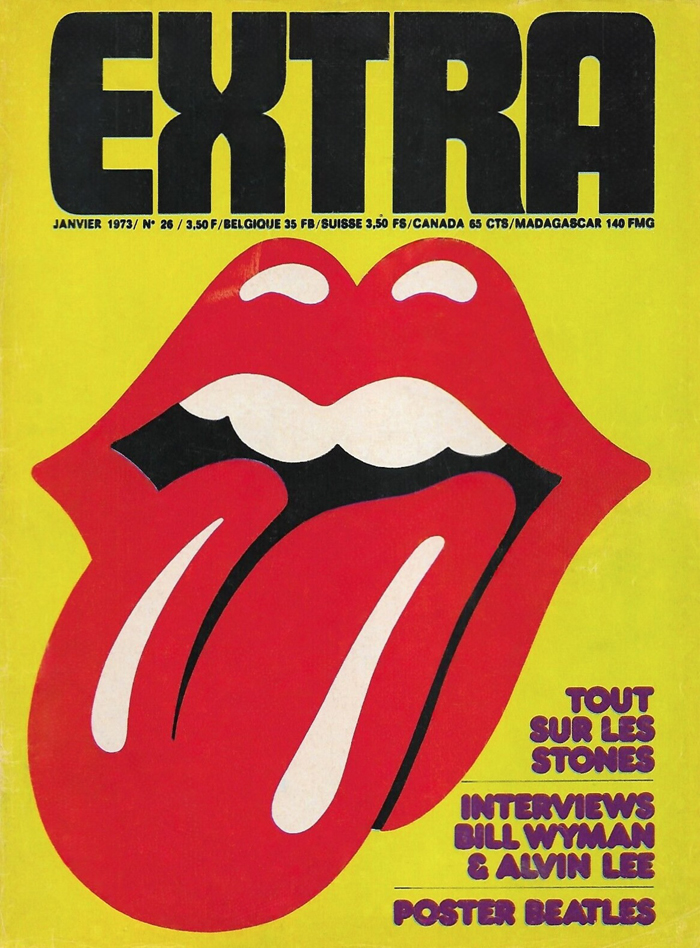
26
January 1973 - EXTRA Magazine, France, Front Page

EXTRA
Magazine - Content






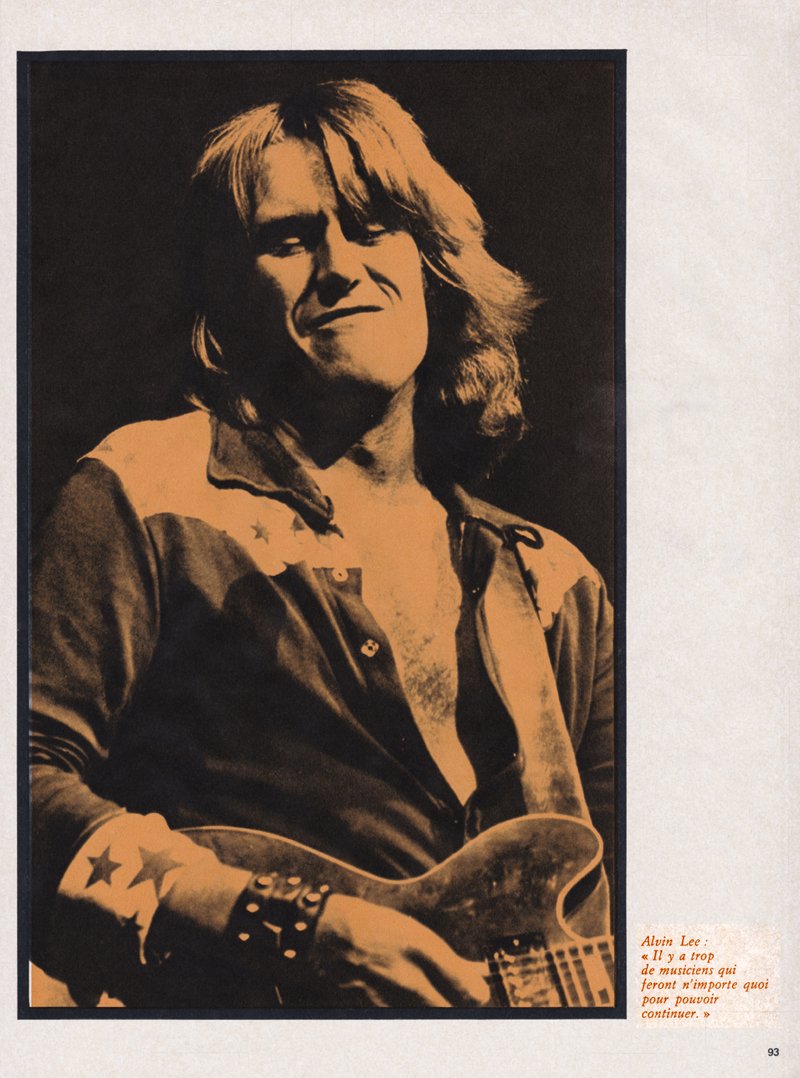
|

1973 Tour Dates in Germany - Many
Thanks to John Tsagas! |

28
January 1970, Festhalle Frankfurt




Leo Lyons -
Germany

|

29 January 1973 -
L'Olympia Paris
Photographer: Claude Gassian
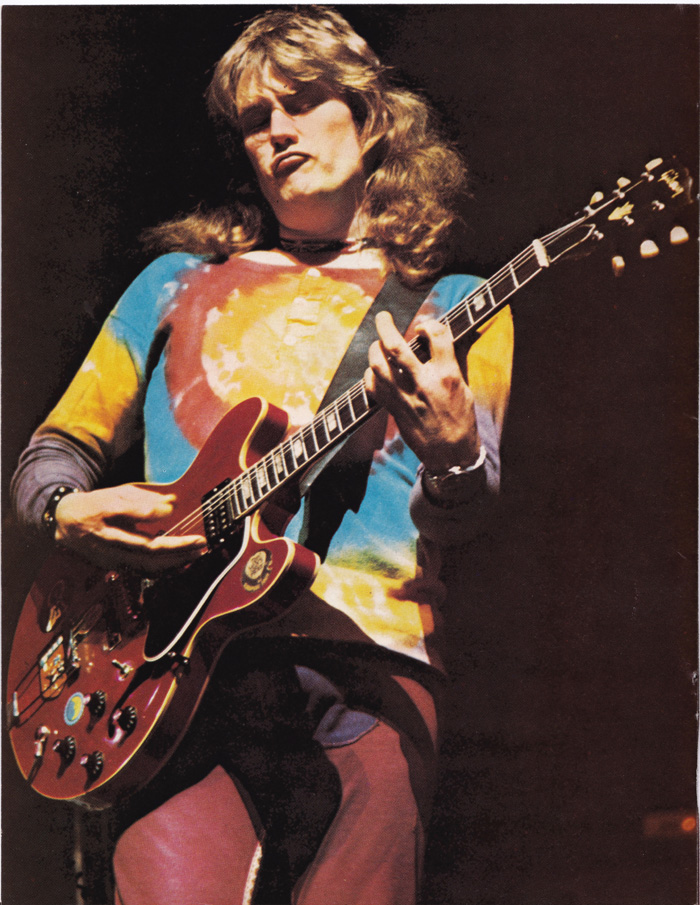
Photographer: Jean-Pierre Leloir
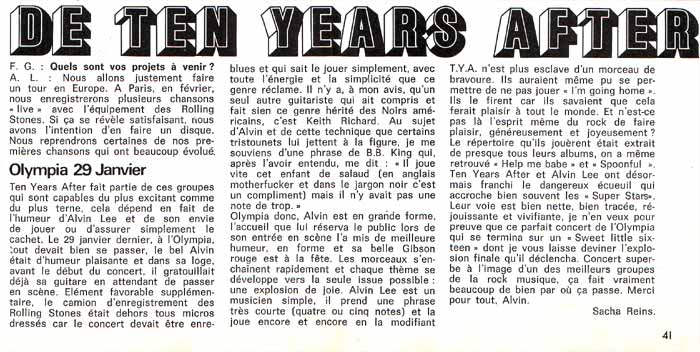
TEN YEARS AFTER
at "Olympia", Paris - 29 January 1973
Rare Contribution from John Tsagas - Thank You John!
|
|
The Berlin Observer, January,
1973
(Thanks to Alessandro)


6 February 1973 -
MAXIPOP, Magazine, France
Photos: Philippe Frin

Front Page



MAXIPOP Magazine, page 16 - Photo:
Philippe Frin

Our Thanks to Wolfgang Stender
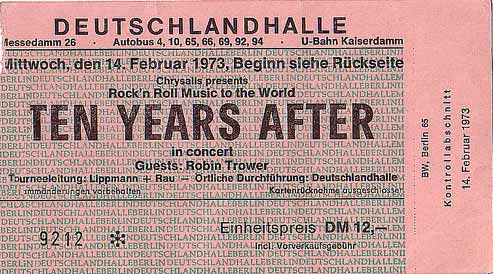



|
ROCKFEST OHNE ROCKER - Feb 19, 1973
Über 8.000 Fans hatten Grund zum Jubeln
Bei Ten Years After bestand Publikum die
Bewährungsprobe
Aus Artikel “Stuttgarter Nachrichten vom
19.02. 1973 A.S.”
|
Many Thanks to
Jürgen Weber
(promoter for concerts from 1973 to 1974)
for
the link
please also visit:
 |
Der von vielen befürchtete Krawall auf dem Killesberg
blieb aus. Über 8.000 junge Pop-Fans zeigten am Samstag,
daß man auch in Zukunft keine musikalischen
Großveranstaltungen in Stuttgart zu scheuen braucht.
Beim Konzert von “Ten Years After” in der Halle 6 des
Ausstellungsgeländes, veranstaltet von dem Kulturellen
Verein und dem “Bird-Laden” in Sindelfingen, wetzten die
Pop-Anhänger eine Scharte wieder aus, die beim Besuch
der “Rolling Stones” und “Deep Purple” vor einigen
Jahren entstanden war.
Immerhin wurden etwa zwei Drittel der Einnahmen für
das Management aufgewendet, um sicher gehen zu können,
dass die Bewährungsprobe wunschgemäß klappt. Und die Fans
haben in der Zwischenzeit eingesehen, dass sie ein
tieferer Griff in die Tasche vor der Konfrontation mit
Schlägertypen als Ordner und vor herausfordernd
schlampiger Organisation bewahren kann.
Obwohl die Saalöffnung offiziell mit 18 Uhr 30
angegeben war, konnten die ersten Besucher bereits vor
18 Uhr die Kontrollen passieren. So gab es auch vor den
Einlässen keine nennenswerte Gedränge und beim
pünktlichen Beginn des Konzerts um 20 Uhr waren die
Siebentausend bei bester Stimmung in der Halle
untergebracht. Als Vorgruppe ging der einstige
Leadgitarrist von Procol Harum, Robin Trower, mit Reg
Isidore am Schlagzeug und James Dewar (Baß und Gesang)
von Stone The Crows, ans Gerät. Obzwar noch nicht ganz
profiliert im Zusammenspiel wurde die junge Formation
mit der schwierigen Aufgabe des Stimmungsmachers für die
Stars des Abends mit Abstand fertig. Sie verzichtete auf
bloß stures Einheizen und lieferte achtbaren
Space-Rock-Blues, der vom Auditorium mit freundlichem
Beifall aufgenommen wurde.
Als dann nach einer kurzen Pause die Mannen von Ten
Years After mit dem Publikumsliebling Alvin Lee auf der
Bühne erschienen, um ihre “Rockn Roll Music für die Welt
(nach dem Motto des Abends) loszulassen, brach wie in
den guten alten Tagen orkanartiger Begrüßungsjubel aus.
Das Quartett, das sich seit elf Jahren mit seinem kaum
je entscheidend veränderten Rock-Stil in gleicher
Besetzung am Pop-Himmel halten kann, bestätigte auch in
Stuttgart seinen Ruf als eine der besten Live-Bands der
Welt. Perfekt aufeinander eingespielt und mit
professionellem Gespür für die notorischen Bedürfnisse
ihrer Anhänger steigerten sie die Stimmung im Saal, bis
schließlich eine hingerissene Menge wogte und rockte und
sich die Kehlen heißer schrie, um noch zwei Zugaben zu
hören.
Dass ausgerechnet die guten Oldies und weniger die
musikalisch etwas anspruchsvolleren Titel aus der
neueren Produktion den größten Jubel entfachten,
bestätigt die Prophezeiungen vom Comeback des Rock´n
Roll, der den Jungen jeder Generation allemal in die
Glieder fährt.
Als sich dann um 23 Uhr die Halle geleert hatte,
machten die Verantwortlichen Bilanz: der Einsatzleiter
der Polizei sprach von einem beispielhaften ruhigen
Abend, das Rote Kreuz hatte – abgesehen von einigen
kleineren, angesichts der riesigen Menschenmenge
minimalen Hilfeleistungen – keinerlei Sorgenfälle. Und
am erfreulichsten war wohl die Mitteilung eines Arztes
der Releasegruppen, die vorsorglich für erste Hilfe bei
Drogenvergiftungen Bereitschaftsdienst hielten: Währen
der gesamten Veranstaltung wurde kein einziges Medikament
benötigt, um “Ausgeflippte” wieder auf die Beine zu
bringen.
Kommentar Rock´n Rolling:
Das Konzert mit Ten Years After war das erste
Popkonzert auf dem Stuttgarter Killesberg nach einer
Sperrzeit von über zwei Jahren. Es war ein Risiko, ohne
jeden Zweifel. Wer wollte das finanzielle Risiko tragen?
Doch auch für Polizei und Verwaltung war dieses Konzert
ein Test, die Probe aufs Exempel, die Antwort auf die
Frage, ob sich weiterhin noch Szenen wie beim letzten
Konzert im Jahre 1971 abspielen würde, als die Eingänge
im Sturm erobert wurde, wo die Polizei sehr gut in
Handgreiflichkeiten mitmischte, wo das Geschäft der
Drogen-Dealer fröhlich blühte. Doch dank unserer
hervorragenden Planung kam es ganz anders als man es
erwarten konnte: Die Polizei und die Stadtverwaltung
äußerten sich nach Konzert-ende sehr zufrieden.
Straff durchorganisiert
“Das lag zu einem großen Teil an den
weitsichtigen Veranstaltern, dem Kulturellen Verein
Sindelfingen e.V und dem Bird-Laden, beide in
Sindelfingen, (nein nicht Schwindelfingen) beheimatet.
Denn mit ihren verschiedenfarbigen Ausweisen, mit denen
Türhüter, Saalordnern etc. ausgestattet waren, erweckten
sie Reminiszensen an die Olympischen Spiele von München
und lösten die Organisationsfragen hervorragend.”
Zitat aus Sindelfinger Zeitung 22.Februar 1973 von Uli
Ackermann.
|

Berlin, Germany 1973
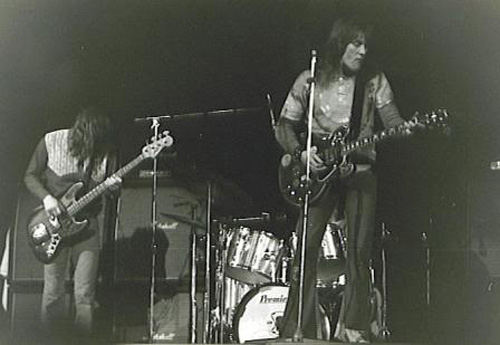

The above photo - from a french article
-
and the below magazine cover are contributions by John Tsagas
and Christoph Müller
March 1973 -
EXTRA Magazine, No. 28, France



March 1973 - BEST
Magazine, France



March 1973 - rock &
folk, French Magazine
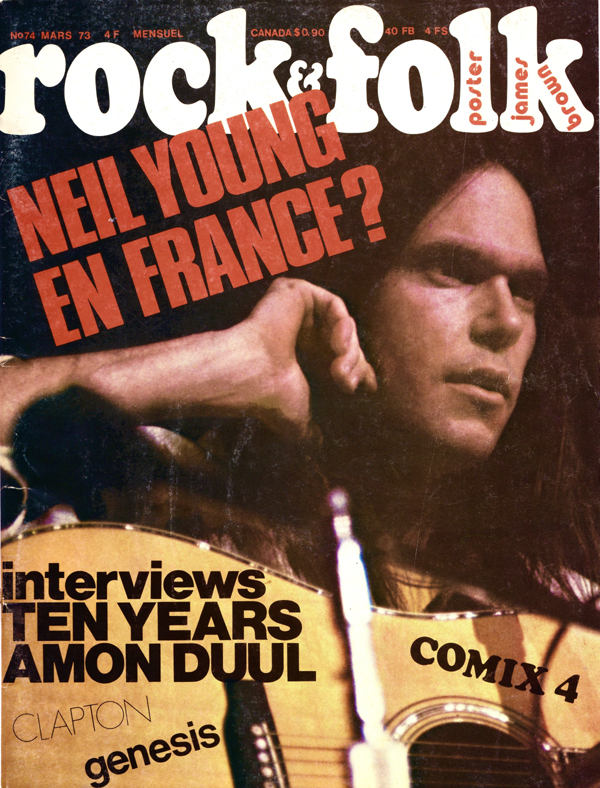
Front Page




rock & folk magazine
/ Alvin Lee at L'Olympia Paris, 29 January 1973
- Photo: Claude Gassian
|
31
March 1973 - New Musical Express
Ten Years After
are to play a string of selected British concerts in
April, before setting out on the second half of their
1973 world tour. Five venues that have confirmed this
week are:
Dunstable Civic
Hall (April 5th), Sheffield City Hall (6th),
Croydon Fairfield Hall (8th), Reading
University (14th), and Guildford Civic Hall
(15th), along with other dates still waiting
to be finalised. The band have just completed the
European half of their world tour, during which they
recorded a live double album, for release by Chrysalis
Records on May 4th. It was recorded on the
Rolling Stones mobile unit at concerts in Paris,
Frankfurt and Amsterdam.
The album is virtually a Ten Years After “Greatest Hits
Bootleg” collection. It comprises of twelve tracks among
which are the following: “I’m Going Home” - “Help Me
Baby” – “I Can’t Keep From Cryin´ Sometimes” and “You
Give Me Loving”. It will retail at the special price of
three pounds. Ten Years After return to America on April
25th and tour there until May 13th.
Then they fly to Japan for a week of concerts, followed
by other appearances in the Far East. A spokesman told
the New Musical Express, that the group are at present
being negotiated for a major London date later in the
year. |
|
New Musical Express – April 14, 1973


Out of all the
bands which made up the Blues Boom, Ten Years After are
the sole survivors.
While the other
bands of that era (witness Fleetwood Mac and Chicken
Shack) changed personnel, Ten Years After kept their
original line-up and, right to this very day, are still,
with a few minor modifications, playing just what they
were playing back then. It’s only, if Sunday’s gig at
Croydon’s Fairfield Hall was anything to go by, how they
play it that’s changed. Then the band had what is rock’s
essential ingredient…excitement. And Alvin Lee and
Company had so much of it they were able to transform in
onto a twelve inch piece of plastic called “Undead”. But
back to Croydon.
The evening
began with a new Warner Brothers signing called
“Beckett”. In truth, the only good thing about Beckett
was their obvious enthusiasm. But the crowd responded
warmly.
“Impatient lot”,
the fella sitting next to me murmured as the audience
slow-clapped the non-arriving Ten Years After. Shouts of
“Alvin Lee” came from the hall, more suited to White
Hart Lane than Fairfield Hall, Croydon, and on they
tumbled, Alvin Lee bringing up the rear.
Then, there he
was dressed in a flamboyant T-shirt behind that big
cherry Gibson guitar.
To his right was
bass man Leo Lyons who, once he had put his fingers to
the strings, became cemented to the spot. Some fine
fluid lines came from Leo’s fingers during their set,
and in “Good Morning Little Schoolgirl” Leo and Alvin
guitar work became as one. Their improvisation was one
of the few times when the band radiated any kind
excitement.
Alvin seemed
disinterested, making inane remarks in between numbers.
“What should we do next?” he asked the band. “A jam in
E”, he decided and that was what followed. When an
audience shells out cash to hear a professional rock
band, it doesn’t usually expect to hear a jam. The flame
began to burn again on “Standing At The Station” but the
classic Ten Years After boogie, “I’m Going Home” failed
to get the audience off. It was only when the band left
the stage that bodies ran to the front of the hall and
really looked like they were getting something out of
the concert. Two short encores followed and that was
that.
Maybe, Fairfield
Hall is too good for a rock concert, too cold, too
plush. There’s no sweat on the walls or stains on the
seats. Ten Years After have survived where others have
fallen, but for how much long
+000000000? Me,11111111 mmmI’ll gohmmmmmome and
get my copy of “Undead” and turn the volume full up just
to remind me that Tn Years After used to be a very
exciting rock band, even if they did call it blues in
those days.
Article by Steve Clarke |
|
CREEM
MAGAZINE – April 1973
Volume
4 – Number 11

|

Lester Bangs
|
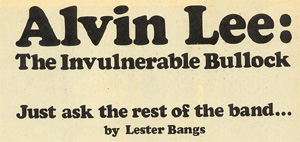
Photos
by Judy Linn and Richard Creamer
Alvin
Lee has the biggest teeth in the world. They’re as
big as a horse’s. They’re BIGGER than Carly
Simon’s. When sitting on the couch in his hotel
suite, he’s a pretty reasonable guy, brighter than
you’d expect a boogie man to be. But you still get
distracted by those teeth, which flash like big
pearly piano keys – except when he shuts up to
take a toke.
Onstage
it’s even worse, because all the lights are
shining on him, and with the adulatory eyes of the
masses on him he can’t help but smile; his
choppers pierce the gloom like two dozen headlights.
|
When he really gets into his music, breaking out
with an especially involved solo in “Goin´ Home”
or leaping proudly back onstage for the “Sweet
Little Sixteen” encore, he forgets himself
completely and starts to grind his teeth with such
ferocity that he looks like Dr. Sardonicus; it’s a
wonder he’s got more than molar stumps at this
point.

When
Lee really gets down to it, though, you can forget
his teeth long enough to dig his whole act. As it
stands now it’s one of the best-honed unqualified
boogie venues on the boards. Lee has been doing
basically the same thing for so long that he’s got
it pat. It’s not boring or cold but Alvin Lee is a
true professional. He knows exactly what his
audiences want, and always gives it to them. If
you’re on the other end of the noise, there’s a
kind of comfort in the absolute predictability that
Ten Years After represent. Half a decade now
they’ve been at it, and if they’re not quite the
monstro superdraw they once were, they still have a
good time. You get the feeling from watching them
play and from talking to Alvin that even years from
now, when the whole pop-star riff is up for them and
they’re back playing bars in England, their music
and their attitude will both remain the same.
When
he’s in full flight Alvin sidles up to the
microphone and grins like a moose. He’s built like
a football player, and his guitar English is in
accordance with the image – none of this fey
barely-touching stuff for Mr. Lee (unless he wuz
touching one of the Bobbettes) – he grits and
grinds and bumps and juts, making it clear without
overstating his virility that he don’t fuck around. He
has a great sense of humour, too – whilst playing
78 RPM ultimo methedrine guitar with one hand,
shacking the mike with the other, bouncing stage
front in a kind of electric slouch (like
a vibrating spring) and singing in the corniest and
most blatant ripoff of something resembling an old
New Orleans Smiley Lewis vocal style ever heard,
he’ll swivel his skull and literally leer at the
audience with glee at once sly and mindless.
Naturally they eat it up.
That
man ain’t no fool.
The
other members of Ten Years After have been resigned
to being out of the spotlight for so long that they
seem almost sheepish about it. I can’t even
remember what they look like right now. When you go
for the interview it’s apparently a tacit,
unspoken assumption that you want to talk to Alvin
and if they come in at all it’s to tell their
manager something or cop a joint. All of which is
too bad, in a way – I still remember Ric Lee in
the movie of Woodstock, thrashing back there behind
the cymbals, licking his drawn lips like a chameleon,
face so literally black and whole visage such a
classic frame of beyond-the pale methedrine
beatitude
(like the cool channel at the eye of the jet stream)
as to summarize the nervous immolation of a whole
generation in one frozen piece of celluloid.
But
that was then and this is now, when Ten Years After
are in some ways the grand-daddies of the whole
blooming boogie-bloozup-getdown school of band which
has proliferated since they first hit the sets.
Savoy Brown copped their riffs in all comradeship,
Cactus would be lost without their model, and Foghat
would never have existed had Ten Years After not
blazed the trail, Alvin hacking away the jungle with
a machete that arced up the frets of his guitar
light years beyond
“Lightnin´ Hopkins” pocket-knife.
They’ve
been around, they’ve prospered and endured, and
now they can afford to kick back just an ampere or a
decibel, cruising on the highway they themselves
laid. The audience doesn’t care, because the fire
is there often enough, on stage or record. Just like
their stage show, their new album “Rock & Roll
Music To the World” is just more of the Same Old
Shit.

“Choo,
Choo Mama,” or “You give me lovin´ that I
can’t return / Bomp Blam / You give me money that
you know I’ll burn…” – but it’s good same
old shit, and all the Ten Years After fans,
including yours truly, are perfectly satisfied with
it.
I recall seeing Ten Years After at a West Coast
concert back in the summer of 1969, and being highly
amused; for a week afterward I went around my job
entertaining anybody who would stand still long
enough with free vocal imitations of the Ten Years
After instrumental sound: “Ah-drnt drnt drnt drnt
DUUUUHH, ah-drnt drnt drnt drnt
DUUUUUUHH,” and then
of course the solo break: “SKREEEEEEEE-harowlarggblunzzzzawonk!”
What
I was too snotty to realize at the time was that
music like that may have been obvious and
one-dimensional, but was still valid as a concept.
Fuck aesthetics – it was still a whole crock of
fun. Nobody will ever be able to accuse Ten Years
After of taking themselves too seriously.
Up
in his hotel suite, Alvin Lee sat back, slouched low
on the couch with his feet sprawled on the carpet in
front of him and the back of his head hitting the
couch at Kilroy level. He looked like a lazy sap but
he was a cheerful fellow, gave us some grass (marijuana)
which made him even more benevolent and made no
bones about where both he and Ten Years After, were
at now and were headed. “We’ve gone the whole
route, from little clubs to ballrooms to festivals
to arenas. When we were in the clubs we’d get
fired for being too loud, or earlier for having long
hair, or for too many long guitar solos. I always
got off on solos, even before it became a sort of
fad, and now I guess some people come for that and
nothing else.”
We
asked him how the concert scene looked now in
comparison with what he’d seen of it all down the
line. “I really wonder,” he said, “why a lot
of people come to concerts these days. The places
have gotten so big that you lose all contact, and
the audiences know what they’re supposed to do.
They wait for a trigger. Like tonight, they were
waiting for “I’m Going Home,” and the instant
it started they were rushing down to the front of
the stage.
“I
would prefer it if the process were more organic,
somehow, with everybody getting off on the music to
the fullest possible extent, all through the evening,
building up to a peak. That’s an ideal situation.
When you play one of these big arenas, you never
know what the audience is thinking. There’s one
out there that’s
listening to the guitar, the next one’s listening
to the drums, the next one’s not paying the
slightest attention … the next one’s really
listening.
So
like we play for our audience, not to it or at it.
There’s a sea of faces, but I see a lot of
individuals, and I play for them. I play for the guy
who’s sitting there and he’s listening to it
just as if he was listening to it through headphones.”
We’re
interrupted by the entrance of the group’s manager,
who hands Alvin a silver mezuzah coke spoon on a
chain, and tells him that it was a gift from a girl
outside. “Where is she?” asks Alvin. “She’s
gone now.” “Uh-huh. Stop trying to cut me off
from Fate.” He’s joking, but in another way he
really means it. He looks at the coke spoon.
“It’s nice but I wouldn’t wear it anyway. But
you should have brought her up.”
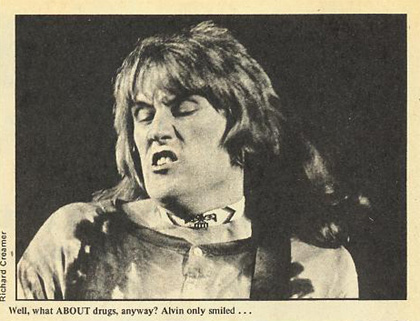
Well
Alvin, we press on, ever alert for some scum, (dirt)
what about drugs?
“I
don’t know … certainly have nothing to tell
anyone else on them, as far as advice goes. I just
smoke grass (marijuana) myself, though I might take
acid again.”
Yeah,
we pry, but you guys are supposed to be the big
speed-freaks!
“Naww,
says Alvin, and launches into a rap that from anyone
else, phrased or intoned a whit more intensely,
would start to seem pretentious on the usual dreary
cosmic levels. He’s such an easy-going, unaffected
cat, though, that it comes out as a simple statement
of operative policy, philosophy if you like, in his
life and his music. “When I go onstage each night
I have to have a certain concentration. We’ve done
tour after tour and if you don’t know how to
handle yourself it can wreck you. I try to keep
things building through the set, but sometimes that
can get me wound up so tight that my jaws are
clenched and I just grind my teeth away. And it’s
really hard to unwind from something like that.
“But I try to get a certain type of concentration
that, if you have it, you can play music or work or
do anything you have to do without spending yourself.
You can block out the distractions and perform at
the peak of your abilities. That’s what I try to
do onstage. I’m usually oblivious to what’s
going on out front; I have to be. If I’m getting
off on it, they will be too. It’s like Baba Ram
Dass said: “I perceive nothing but what is
essential for me to perceive in the present moment.”
He had to go to the Himalayas to find it, and he was
a Harvard professor!”
Yeah,
we said, but what else would you expect from one of
them? Tumbling headlong into a rare non-boring
discussion of whether cosmo dudes in the line of
Baba R.D. and Leary are or are not worth their
weight in shit. Alvin Lee maintained that they were,
to at least a limited degree, and said that he had
gotten some good advice and hot tips out of Ram Dass´
last book, "Be
Here Now”. We said that the reason that Dass the
Ass’s Himalayan guru didn’t come on to all that
acid he gave him was probably because the old fart
was too stupid! Alvin said he wouldn’t know about
that, so we changed the subject to football, or more
precisely the wide world of sports in general:
Are
you a frustrated athlete? We asked shyly.
He
pursed his lips, relaxedly swinging the coke spoon
in an arc around his head, and considered the
question:
“Well,
no, but I have wondered what it would be like to
play professional football. It must be like being an
invulnerable bullock.”

Before
he’d even consent to let us talk to his charge,
Ten Years After’s manager had fixed us with a
probingly icy stare and said: You’re not going to
ask all those stupid questions like “what kind of
guitar strings do you use,” are you?” Sheet no,
we said. We’re pros! And since we had comported
ourselves in such pro like manner as to keep the
interview at a properly lofty level of intellectual dialogue up till now, we decided it
would be even more pro-like and super-cool to say
fuck it and make idiots out of ourselves, so we shot
from the hip:
What
kind of guitar strings do you use, Alvino? The next
question was going to be, did your parents name you
after Alvino Rey?, but he didn’t answer the first
one, so we never got around to it. Instead he
laughed and said: “It’s really funny, ya know. I
could never be the kid who’s screaming out in
front of the stage. Not anymore; there’s no way I
could ever put myself in his shoes at all. People
that wait in line to see you, or shake your hand.
But I was just like them once. I remember the first
time I met Eric Clapton. I was going to be real
cool, not act like I was just some kid. When I
wanted more than anything else just to shake his
hand. So when I finally met him I blew it, blew my
cool entirely. I shook his hand and he looked at me
and I started asking him every one of the usual
stupid questions. The first thing, the very first
thing I asked Eric Clapton was, what kind of guitar
strings he used. And now I can’t even remember
what he said.”
Note
About Lester Bangs:
Born
December 14, 1948 in California - Died April 30,
1982 in New York City. Leslie Conway Bangs, was the
great gonzo journalist, gutter poet and romantic
visionary of rock criticism. No writer on rock and
roll ever lived harder or wrote better. Guzzling
booze and romilar like water. Dead at age 34.
|
April 1973 -
popfoto Magazine - Germany and Netherlands
published in June 1973
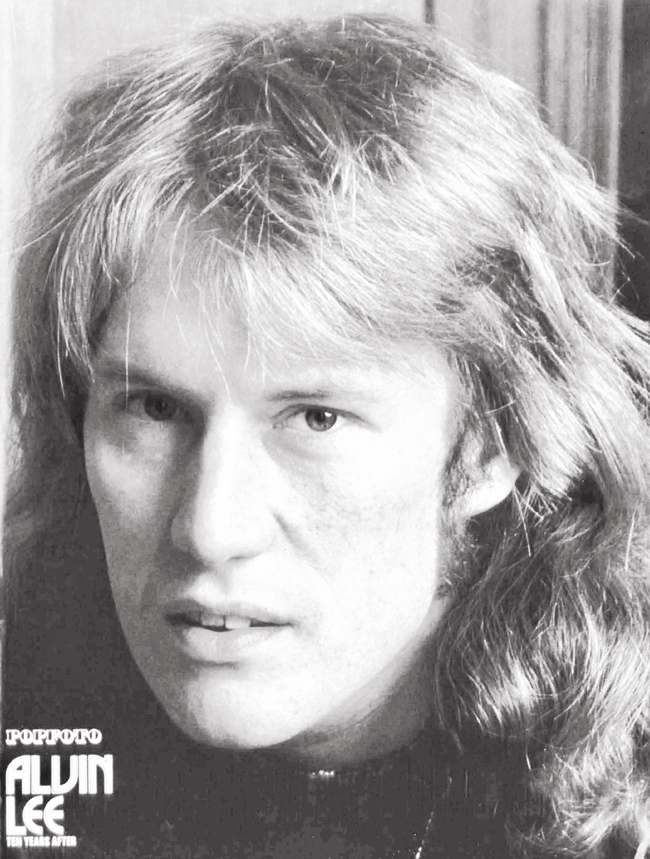
black & white photo

colour photo
April 1973 -
Musik Express Magazine, Germany

page 59


MUSIK EXPRESS 1973
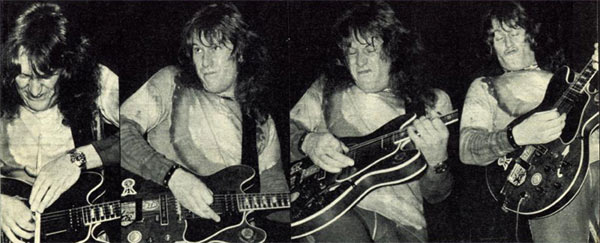






New
Musical Express – April 21, 1973
ALVIN GOES
SOLO
Alvin Lee will record a solo album when Ten Years
After return home from their tour of America and the Far
East, which starts next week. A Chrysalis spokesman told
New Musical Express: “There are definitely no plans for
Alvin to leave the group.
Ten Years After will play together soon after they
return from abroad, a major London concert is planned.” |
 |
Ten Years After
From Melody Maker 4/ 21/ 73
Past:
Alvin
and Leo were originally part of a Nottingham power trio
called the Jaybirds, but TYA with Chick and
Ric came to prominence in London as the Psychedelic Era
melted into the Blues Boom, around 1967.
Alvin
was flash and fast, and the lack of character in the rest
of the band never mattered.
Their
appearance at Woodstock, featuring Alvin’s guitar
marathon was a turning point on the road to worldwide Sell-out status.
Present:

These
days they seem not to believe in over-working themselves,
concentrating on infrequent well planned
concert
tours and the occasional album. Live appearances rely
heavily on old material , and judging by the
charts
their recent albums don’t appear to have sold
fantastically well.
Future:
It
seems doubtful that they can continue much longer with
this format—their musical horizons were never
considerable,
and their abilities limited. Alvin Lee will almost
certainly form a new band, which might
rejuvenate him, ‘cos he’s always had the makings.
|



27 April 1973 - Concert Review -
Dayton Trotwood Ohio, Dayton Hara Arena
|
May 1, 1973 – Ten Years After –
Robertson Memorial Field House
The Bradley University Campus Peoria, Illinois
|
|
Ten
Years After - Alvin Lee

Melody
Maker 5/ 5/ 73
Ten
Years After, who became one of the super groups of the
sixties, culminating their career with a triumphant
appearance at the Woodstock Festival, started their career
as an 18 a night band at the Marquee.
Alvin
Lee in New York this week shared the views of many fellow
musicians, that without the break the
Marquee
gave them, it might have been a different TYA story.
Says
Alvin: “of all the clubs in London in those days, the
Marquee was the most important. I remember
That
Leo (Lyons) got us an audition there, and we were all very
scared of John Gee. He was very strict you know.
He’d
tell all the bands they had to be in the dressing room a
quarter of an hour before they were due on. “And
He
used to time the road managers at work. Many a band never
really a stepping stone.
The
last time I played there I got to play there again if the
roadies were slack. But we knew John Gee was a jazz
fan
so we did a quickly improvised version of
“Woodchoppers Ball” and we got a gig. A lot of
bands used to say they
were big fans of Frank Sinatra to get in.
“Our
first gig there was an interval spot for half an hour, and
we had to follow the Bonzo Dog Band. The stage was
literally smothered in blue smoke from their explosions ,
and we had to go and play. But we managed
to
build a small following among the blues freaks and got a
residency in 1966.
We
did a Christmas show when we went down the queue outside
playing banjos. We got a quid in the hat, and
some
people even crossed the road to give us money. They
thought we were genuine buskers.”“They
were a very attentive audience at the Marquee and they
didn’t clap a lot. Some musicians didn’t
like
that, and it wasn’t until later the audiences started
going wild. I was quite in awe of that place.
I
remember going to see groups there before we started.
People like Peter Green with John Mayall, and a gig
there
was passed out on stage, through lack of oxygen. It was
during the last number and I completely
blacked
out. They had to rush me to hospital. It was about three
years ago, and the size of the audience was
beginning
to get uncomfortable.
“But
I still like the feel of playing in a sweaty club. The
sound is so much better and you get more interaction with
the audience, instead of just being a performer upon the
stage. “I don’t see why we couldn’t play there again,
but
it might be a disappointment, as we are more in tune with
big concerts now. I’d like to have a jam there.
you
know, I always used to get nervous playing the Marquee. I
only lived three miles away from the club but
but
it seemed a very important gig. I can play to 20,000
people in New York and it doesn’t worry me at all.”
Did
Ten Years After ever contribute to the famed graffiti wall
in the dressing room? “I’m
sure we wrote something, I can’t remember. But my girl
friend told me they had my name written on
the
wall in the ladies. So that was some kind of status symbol!”
|
BRAVO MAGAZINE
From May 22, 1973

TEN YEARS AFTER
“Rock & Roll Music to the World”, nennen Ten Years After
ihre jüngste L.P. Sie ist ihre siebte und
erfolgreichste. Auf ihr rocken die vier Engländer hart
und heiss und ohne Schnörkel. Seit drei Jahren spielen
Ten Years After Rock ´n´Roll. Damit füllen sie die
grössten Hallen dieser Welt, damit sind sie auf der
Bühne die strahlenden Stars. In Frankfurt erzählte Ten
Years After – Boss Alvin Lee BRAVO die Geschichte der
britischen Gruppe, die eigentlich im Sommer 1966 im
Hamburger „Star Club“ begann...

TEN YEARS AFTER:
Anfangs pfiffen uns die Rock – Fans aus
Vor sieben Jahren sah Deutschland für uns noch ganz
anders aus, “erzählt Ten Years After – Sänger und
Sologitarrist Alvin Lee.“ Da feierten uns keine 6,000
Fans –so, wie heute abend.“
Jetzt, sieben Jahre später, strahlt Alvin Lee über das
ganze Gesicht. Gemütlich sitzt er bei „Karrenberg“,
einem exklusiven Speiserestaurant in der Frankfurter
Innenstadt. Genugtuung über endlich Erreichtes strahlt
aus seinen Augen. „Damals, 1966, nannten wir uns noch „Jaybirds“
und spielten in Hamburg – im Star-Club. Der sollte für
uns das Tor zum Ruhm werden. So wie er es für die
Beatles war. Dachten wir. Stundenlang schufteten wir wie
die Wahnsinnigen, spielten Blues und viel reinen Jazz.
Doch der Erfolg blieb aus. Zumindest waren wir davon
überzeugt, wenn wir nach der Vorstellung die kahlen und
feuchten Wände unseres Zimmers sahen. Die Rocker hatten
uns im „Star Club“ zuvor regelmässig ausgepfiffen.
Glücklicherweise waren im Star-Club auch immer ein paar
Studenten, bei denen unsere Musik ankam und die uns Mut
machten. Aber davon wurden wir nicht satt.
Leo spielte Filmstatist
Darum nahm unser Bassist Leo Lyons noch Statistenrollen
in Filmen an, die gerade in Hamburg order in der
Lüneburger Heide gedreht wurden“.
Fast ein halbes Jahr blieben Ten Years After in Hamburg.
Einen Sommer lang traten sie dort auf. Doch als sie in
ihre englische Heimatstadt Nottingham zurückkehren
wollten, trennte sich Sologitarrist John Kelly von
seinen Freunden. Er wollte einfach lieber in Hamburg
bleiben.
„Wir aber brauchten unbedingt einen neuen, vierten Mann.
Allerdings hatten wir in Hamburg so viel gelernt, dass
wir nur einen Organisten suchten. Damit hätten wir
musikalisch mehr Möglichkeiten. Anfang 1967 fanden wir
ihn – Chick Churchill. Kollegen priesen ihn als
Wunderkind. Aber Chick besass keine Orgel und wir kein
Geld, um ihm eine zu kaufen.

Damit keine andere Gruppe uns Chick vor der Nase
wegschnappte, verpflichteten wir ihn erst mal als
Roadie.“ Chick nahm an, schleppte die paar Verstärker
der Gruppe, während Alvin Lee den Bandbus fuhr und Leo
Lyons sich als Manager um neue Jobs kümmerte. Alvin „Das
ging plötzlich besser als erwartet. Wir bekamen
Auftritte im Londoner Marquee und im Roundhouse.
Außerdem behaupteten die Clubbesitzer auch nicht mehr,
wir würden mit unserer Musik alle Gäste vergraulen,
obwohl wir immer noch Blues und reinen Jazz spielten.
Hamburg hatte uns doch etwas Glück gebracht.
“Der entscheidende Durchbruch aber gelang Ten Years
After beim“ 7. National Jazz-und Bluesfestival“ in
Windsor. „20.000 Leute feierten uns, und die Zeitungen
schrieben Lobeshymnen wie über keine andere Gruppe. Das
brachte uns einen Plattenvertrag ein, den wir dann im
Juli 1967 unterschrieben.“
Neuer Name und alte Musik

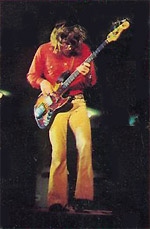 Schon einen Monat später erschien die erste LP: „Ten
Years After“. „Den Namen fand Leo Lyons beim Blättern im
Rundfunkprogramm. „Ten Years After“ (Zehn Jahre danach)
war eine damals sehr beliebte Sendung. Uns gefiel der
Name sofort. Allerdings hatte er für uns keine besondere
Bedeutung“. Schon einen Monat später erschien die erste LP: „Ten
Years After“. „Den Namen fand Leo Lyons beim Blättern im
Rundfunkprogramm. „Ten Years After“ (Zehn Jahre danach)
war eine damals sehr beliebte Sendung. Uns gefiel der
Name sofort. Allerdings hatte er für uns keine besondere
Bedeutung“.
Mit dem Namen wechselten die vier aber nicht ihre
Musikrichtung. Bis 1969 blieben sie dem Blues treu. Ihre
nächsten LPs „Undead“ (August 1968), „Stonedhenge“ (März
1969) und „Ssssh“ (August 1969) wurden langsam immer
rockiger. „Trotzdem hatten wir damit nur bei Jazzern und
Undergroundfans Erfolg. Geld verdienten wir immer noch
wenig“. langsam immer
rockiger. „Trotzdem hatten wir damit nur bei Jazzern und
Undergroundfans Erfolg. Geld verdienten wir immer noch
wenig“.
Woodstock – das war die Wende
 Das kam erst nach dem schon legendären Auftritt am
16. August 1969 beim Woodstock-Festival. “Neun Minuten
und 20 Sekunden genügten – und wir waren weltberühmt. So
lange nämlich spielten wir unseren Rocktitel „I’m going
Home“. Plötzlich hatten wir Fans in der ganzen Welt und
füllten bei Konzerten die grössten Hallen. Aber die
wenigsten Leute wissen heute noch, dass wir einmal
begeisterte Jazzer waren. Wenn wir unsere alten Songs
spielen, wundern sich viele, dass eine Rockgruppe auch
jazzen kann“. Das kam erst nach dem schon legendären Auftritt am
16. August 1969 beim Woodstock-Festival. “Neun Minuten
und 20 Sekunden genügten – und wir waren weltberühmt. So
lange nämlich spielten wir unseren Rocktitel „I’m going
Home“. Plötzlich hatten wir Fans in der ganzen Welt und
füllten bei Konzerten die grössten Hallen. Aber die
wenigsten Leute wissen heute noch, dass wir einmal
begeisterte Jazzer waren. Wenn wir unsere alten Songs
spielen, wundern sich viele, dass eine Rockgruppe auch
jazzen kann“.
Seit Woodstock wurden Ten Years After immer härter. Ihre
LPs „Cricklewood Green“ (1970), „A Space in Time“ (1971)
und die letzte LP „Rock & Roll Music to the World“
begeisterten immer mehr Rockfans. „Jetzt spielen wir
fast nur noch reinen, harten Rock. Nur wer genau
hinhört, kann noch leichte Jazz- und Bluesanklänge
entdecken.
K. E. Siegfried
 |

June 1973 - TEN YEARS
AFTER "Recorded Live" - Front Cover



|
Goldmine
Magazine 1/ 12/ 83
Ten
Years After – Recorded Live 1973
Recorded
in 1973 in various European locations, this album was
originally on two LP’s and now makes it onto one 72
minute CD. That’s a great bargain, especially when
you consider that the sound quality is pretty damn
good (not as radiant as you’d hope for, but pretty
damn good). Unfortunately, it’s a rather dull album
– was then, still is. By 1973 Ten Years After had
surpassed their performing peak, and the group had
long ago become little more than a showcase for
guitarist Alvin Lee’s excesses, borne out here by
two 11-minute-plus tracks and one 16-minute take on Al
Kooper’s “I
Can’t Keep From Crying Sometimes.”
That
Lee was a dynamic flash guitarist isn’t in question,
but that his flashes don’t quite work anymore is
also true. Ten Years After initially released this as
a response to bootlegs proliferating at the time, and
one supposes it served its purpose then. Today,
you’d have to be a true loyalist to sit through all
72 minutes – without a break or three.
|
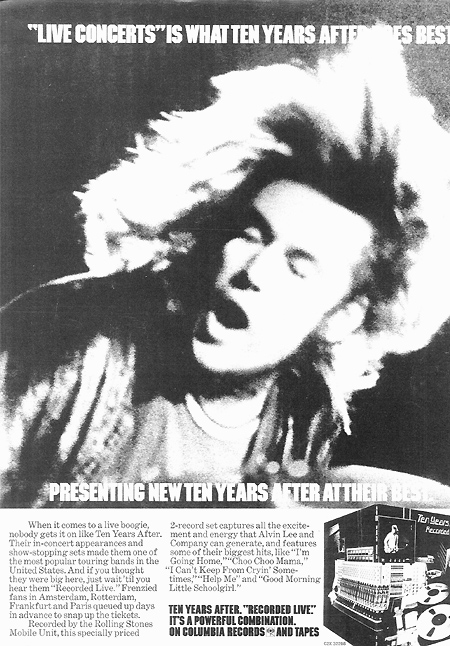
|
Presenting
New Ten Years After At Their Best.
Ten
Years After “Recorded Live”. It’s a powerful
combination.
When
it comes to a live boogie, nobody get’s it on like
Ten Years After.
Their
in-concert appearances and show – stopping sets,
make them one of the most popular bands in the United
States. And if you thought they were big here, just
wait till you hear them “Recorded Live”,
Frenzied
fans in Amsterdam, Rotterdam, Frankfurt and Paris
queued up days in advance, to snap up the tickets.
Recorded by the Rolling Stones Mobile Unit, this
specially priced two record set captures all the
excitement and energy that Alvin Lee and Company can
generate, and features some of their biggest hits,
like “I’m Going Home” – “Choo-Choo-Mama” -
“I Can’t Keep From Cryin´ Sometimes” –
“Help Me” and “Good Morning Little School
Girl”.
|
|
Ten
Years After
Recorded Live 1973 – Album Review
I’ve
just read Ray Telford’s review of the new live album
by Ten Years After and I can’t believe it. He says
Alvin Lee’s guitar style hasn’t changed. Well no
guitarist changes his style much. The dreadful Hendrix
never changed and neither have people like Page and
Clapton.
Mr.
Telford also says that Ric Lee is kept to the
background. Yet the first track on side two is an
incredible seven minute drum solo from Ric. If anyone
was put off buying the LP. By the review, take my
advice and buy the album.
By
Trevor Hogg
Gateshead, Co. Durham
|

|
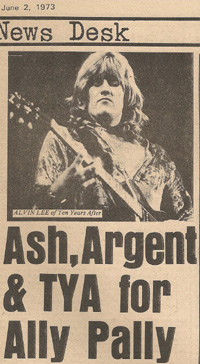

New Musical Express
June 2, 1973
|

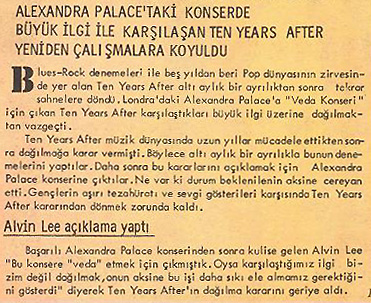
|
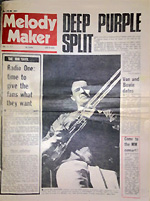
Melody
Maker - June 23, 1973
TEN YEARS AFTER: TEN YEAR ITCH
By Chris Welch
When does a band become a jukebox? And when does it
cease to be a creative musical force? These are the questions that have been worrying Alvin Lee. But it
does not necessarily signify an end to Ten Years After,
the band born of the British blues boom that became one
of our most popular rock exports to America. Ten Years After are still alive and well and touring
the world, despite growing press criticism and an apparent
inability to progress. There are progressive bands in
this world, and those destined to rock on. TYA are one of the
latter.
But they intend to fight off stagnation , and a serious
reappraisal of their entire structure is underway.

LOYAL: While some claim that Ten Years After are ten
years out of date, they can still command a happy and loyal following in the countries they visited in the
early part of this year, which for the record included Europe, England, America, and Japan. They could probably afford
to carry on regardless, playing the same tunes and completing their twentieth
(it’s a fact), tour of the
States. But as Alvin explained to me this week besides his
sun drenched swimming pool, on the borders of a manor
house, parts of which date back to the 15th
century: “There’s a million things I want to do.” Alvin
has just completed three lengths under water, without coming
up for air, when I arrived, and was catching his breath.
PALLOR: Health-giving fruit juice arrived and the
pallor of a thousand night clubs and dressing rooms was dispersed amidst this earthly paradise. “ The last
tour was a good one,” said Alvin, idly spotting newts in the nearby rock pool. “It was like going to the States a
couple of years ago. We played a lot of smaller towns and the
audiences were just that bit keener which was nice. “
We did a few gigs with the Strawbs and they were doing very well, and getting good reactions. I was really
surprised when they split up. “ English bands still have a
good name in the States and I suppose the reason is they
have to get good in England before they can go across.
“it’s funny, but there are a lot of American bands being
influenced by us, and you hear guys singing with English
accents. We took our influences from America, and now
they are taking them from us. “But I don’t see anything apart from that happening. There’s nothing
happening in New York except a trend towards country music. “And the radio stations seem to be changing
their policy. It used to be the FM stations played underground music and AM played pop. Now the
underground has turned into contemporary pop which AM
plays, while FM seems to be going for easy listening
and classical.” Alvin recalled that one of the highlights of their last
US tour was a concert for 10,000 fans at a resort called
Big Surf in Arizona. As the State is many miles from
the coast, they have built their own sea—a man made lock, with a hydraulic machine to create six foot waves.
“The lake is about a mile long and has its own beach and surfing. At the end of the gig, the audience jumped
into the lake!”
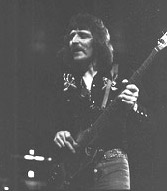 But what is the future of TYA, I asked, attempting to
spot the newt that Alvin was spotting. “We had planned to take three months rest, but there are no future
tours planned as yet. It’s the first time we have ever sat
back. The rest of the group is scattered on holiday all
around the world. “For some time I’ve had the feeling that
we had started to turn into the old travelling juke box again.
We do have a new live album due out, which was recorded in
Frankfurt, Paris, Rotterdam and Amsterdam on the
Rolling Stones mobile, featuring most of the best numbers
we do live. “It’s an answer to the bootleg albums
that have been issued. We’ll also be doing one of the
Alexandra Palace concerts.’’ ‘I’m busy building
my own studio, and there will be a lot of recording projects
there including Ten Years After. “But we’ve got to
wait and see what happens. We’ve become directionless
musically. The music we play, we play naturally, and we
play what we like. It’s been relatively successful. “But we’ve got to find
But what is the future of TYA, I asked, attempting to
spot the newt that Alvin was spotting. “We had planned to take three months rest, but there are no future
tours planned as yet. It’s the first time we have ever sat
back. The rest of the group is scattered on holiday all
around the world. “For some time I’ve had the feeling that
we had started to turn into the old travelling juke box again.
We do have a new live album due out, which was recorded in
Frankfurt, Paris, Rotterdam and Amsterdam on the
Rolling Stones mobile, featuring most of the best numbers
we do live. “It’s an answer to the bootleg albums
that have been issued. We’ll also be doing one of the
Alexandra Palace concerts.’’ ‘I’m busy building
my own studio, and there will be a lot of recording projects
there including Ten Years After. “But we’ve got to
wait and see what happens. We’ve become directionless
musically. The music we play, we play naturally, and we
play what we like. It’s been relatively successful. “But we’ve got to find  something to get our teeth
into. We want to do more rehearsals and arrange more music
to carry us forward. “There are things I want to do
on my own as well. Next month Felix Pappalardi is coming
to stay with me and Mylon and Alan Toussaint. We’ll be recording an album in my own studio, and it’s
going to be very heavy. “Allan has been doing production,
but he’s a piano player and wants to get back into playing.
Felix will come a bit later to play bass, and Ian
Wallace will be on drums. “We’ll also be doing a thing
with Ian and his sidekick Boz. They have a funky rhythm section
going and the idea is to do an English Muscle Shoals. something to get our teeth
into. We want to do more rehearsals and arrange more music
to carry us forward. “There are things I want to do
on my own as well. Next month Felix Pappalardi is coming
to stay with me and Mylon and Alan Toussaint. We’ll be recording an album in my own studio, and it’s
going to be very heavy. “Allan has been doing production,
but he’s a piano player and wants to get back into playing.
Felix will come a bit later to play bass, and Ian
Wallace will be on drums. “We’ll also be doing a thing
with Ian and his sidekick Boz. They have a funky rhythm section
going and the idea is to do an English Muscle Shoals.
“We’ll make an LP with myself, Boz, Ian and Mel
Collins, who is an excellent musician and a good arranger.
“I’m learning a lot by working with guys like Mel.
In Ten Years After we all listen to similar people. “These blokes are laying records on me by people I’ve never
heard before. My style is broadening a lot and it’s been
very beneficial. “The advantages of working with the
same people for years is that you can feel what each other is doing. But after a while you can get into a
rut.”
Are the rest of TYA happy at Alvin’s involvement with
other musicians? “Oh yeah. The thing is, I want to remain active, and
to learn more. TYA will pull through and anyway, the others have different projects too. At this stage, we
just need to rehearse.” What was the alternative? “The
alternative was nothing. We could carry on touring, but
the music would suffer and we need fresh ideas. “I’ve
been listening to bands like Focus and the Mahavishnu
Orchestra, and I
don’t want to be a dated musician. I want to stay with what’s happening. “I’m forming
my own production company to release the albums we’ll
be doing here, and we’ve got all the facilities and
freedom to do so many different things. “I could go on
touring, but that’s time consuming and my real
ambition is to find a new music altogether, something that
nobody has touched upon. “I have all the facilities,
so there is no excuse for me not to do something amazing. That’s what I keep telling myself anyway. I’ve got
to shame myself into doing things!”
BARN: Alvin’s studio is situated in a converted barn
and is so huge that it dwarfs many top London studios. Equipped with a 16 track machine, it has the further
sophistication of a remote control unit, which will enable
Alvin to record himself from the studio floor, without
having to climb the stairs to the control room. Ancient beams support the roof, hundreds of years old, now
being sealed off with soundproofing material which Alvin
and friends put up themselves. But the bulk of the work
is being done by contractors and the courtyard of the manor currently resembles a building site. The manor,
with its indoor tennis court (once a milking shed), swimming pool, sauna, cattle pens, duck ponds,
greenhouses, and acres of surrounding countryside, was once
the home of millionaire Charles Clore. It’s expensive
to keep up, even for a successful rock idol. And collecting the water rates from local cottages won’t
be any subsidy. It depends on whether Alvin can make his
ambitious studio project earn some returns, before he
can be assured a permanent home.
DESK:
“We started work on the studio about six months
ago, and the desk was built by Dick Swettenham
who built Olympic Studios’ which is reckoned to be the
best. He’s a genius, and the new one is really space age.
“We’ll start sessions with Mylon in July, but up to 3:30 last
night, we were still putting up soundproofing. “Ten Years After have made eight LP’s and the money
we spent in studio time we could have bought our own one.
“This will eventually be the best studio in the world.
We’ll run it on a private basis, but it will be nice to get
some good selling LP’s out. “Essential in fact, or I’ll be moving sooner than I
want.”
 
|

23 June 1973 -
Sounds newspaper, England


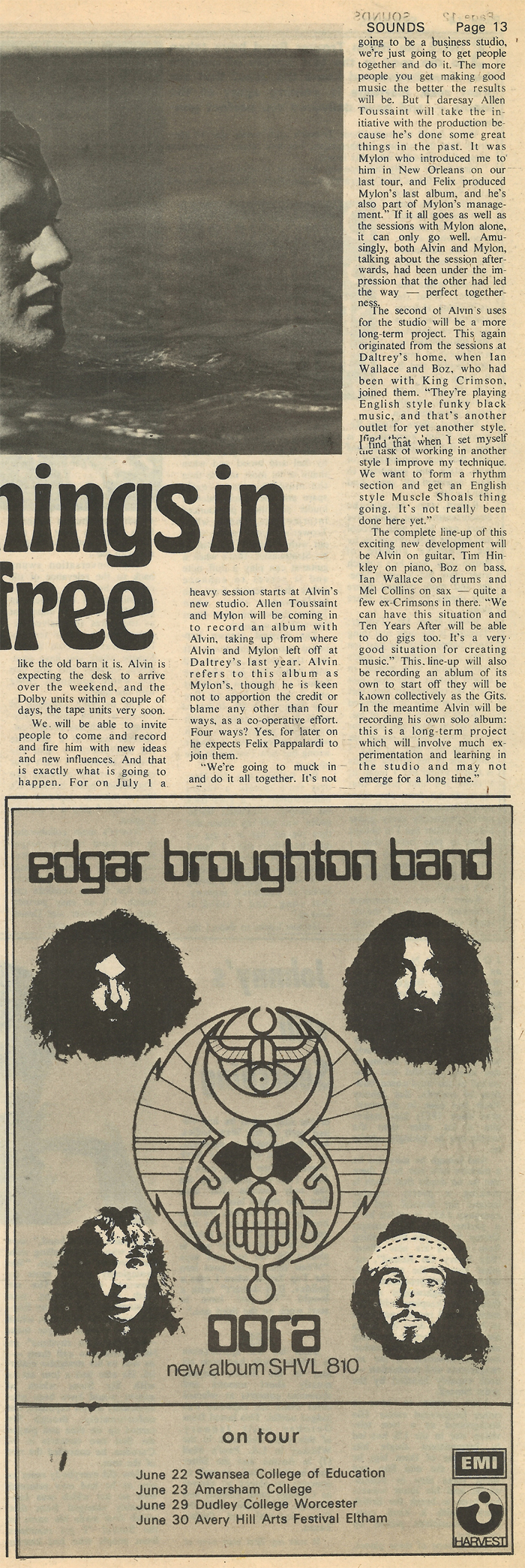
|
Taking
Care Of Business – Music Trade News

By
Chris Hayes - 1973
Alvin
Lee: Converted Barn
ALVIN’S
STUDIO:
Alvin
Lee – Lead guitarist with Ten Years After, has
created a modern luxury recording studio out of an old
barn in the grounds of his five hundred year old house
in Oxfordshire.
Designed and built by musicians, rather than
technicians, it took six months to complete and will
be used exclusively by Alvin and his friends, starting
with a big session for an LP now in progress,
featuring Alvin Lee, Ian Wallace, Mel Collins, Boz
Burrell and American musicians, Mylon LeFevre, Alan
Toussaint and Felix Pappalardi.
Alvin’s
assistant and studio engineer is Harold Burgon, an
electronics freak, who also plays guitar and piano,
has formed a production company called “Space
Productions” to handle recordings made in the
studio.
Equipment
comprises Studer 16 and 2 track machines, M16 Dolbys,
Helios eighteen channel desk, Tannoy and JBL monitors,
Radford power amplifier, Neumann, AKG and Sure mikes,
EMT echo plate, two Revox tape loops and a desk fitted
with a special remote box, which can be operated by
one person and has constant impedance direct injection
input.
|

WHEN a musician
refers to his band as a travelling jukebox, as Alvin is
liable to describe Ten Years After these days, it’s a sure
sign that the band is no longer the creative force it once
was.
In the case of Ten Years After that’s exactly how Alvin Lee feels. It’s a
problem that’s worried him for sometime now, and
indirectly is one reason why he’s looking forward to
opening his new studio that’s built into a barn standing
on one of the forty acres of his enormous 15th
century manor house that’s located near Reading.
This is to
be the setting for some activities Lee has planned outside
the auspices of Ten Years After and which he hopes will
eventually benefit the band as a whole.
The house
once owned by developer Charles Clore, is impressive even
by the highest standards of the rock aristocracy. There’s
wood panelling, a maze of rooms and that odd kind of eerie
stillness
|

|
|
that lends to hang
in the air at some stately homes.
It’s especially apparent around the
main hall and staircase, where you feel you ought to tread
lightly and speak only in whispers.
Things are
different in the kitchen though, the gathering point for
the twelve man crew that have been working on Lee’s new
studio outside.
|

|
However, combining now with other musicians has already
helped him considerably. “My own guitar playing has come
along incredibly since I started playing with new people,
also they’ve been turning me on to new musicians I’ve
never even heard of before. “It seems like a lot of doors
have suddenly opened, I feel now I’ve given myself the
opportunities and facilities to do anything possible.
|
The beamed ceiling looks down on a plethora of
activity while Lee himself moves around taking it
all in somehow with the style of a pleasant but slightly
pre-occupied lord of the manor.
In one sense he worries about Ten Years After being
groundless, since their popularity appears to be as strong
as ever. They’ve just completed their 19th tour
of the States, followed by a series of dates around Japan.
There’s little to suggest that the band couldn’t carry on
in a similar vein for several more years to come.
In fact it all seems so easy to keep Ten Years After rock and roll
machine on the road, and the money pouring in, that
they’ve already been accused of simply working out until
their retirement.
It’s that kind of impression that Alvin Lee is trying to
avoid.
At present
he lives a luxurious life style, but by the time he’s
finished the studio he confesses that he’ll be set well
back financially. Also he rightly points out that Ten
Years After have always been a hard working band, out on
the road somewhere in the world for most of the last seven
years. That perhaps, is part of the trouble now. That kind
of continuous work can make a band stale, directionless –
just a travelling juke box perhaps.
Alvin Lee at least has seen the danger signs.
As the rain poured down outside
he explained with admirable honesty:
“Every band has their limitations and as we’ve been
together so long we’ve tended to fall into old grooves and
styles of playing rather than attempt anything new.
“Every band has their limitations and as we’ve been
together so long we’ve tended to fall into old grooves and
styles of playing rather than attempt anything new. |
For example
I found my guitar playing was, if not exactly standing
still, maybe going round in circles, along with my
writing.
“I think
we’re still progressing, but the process has been getting
slower and slower.
I think it
can happen to any band who stay together for so long. We
were very experimental and now it’s just fallen into a
format. “ It was bound to happen in a way, you can’t
expect to blow your own mind every night….but if you don’t
it gets to the point where playing is just really work. I
mean, I don’t think any of us listen now to the type of
music we play – which is really rather amazing. I can’t
listen to a heavy record now without getting super
critical about it.
"Up
till about a year ago I was intent on taking Ten Years
After and my own style within the band as far as it would
go. Then I reached a point where I seemed to come up
against a brick wall and I decided that I needed a lot of
other influences to help me through it.”
Since the
whole band felt much the same way, the solution was to
take five months off, experiment with new ideas on their
own and then come back and work on the band’s music from
there. Alvin Lee also emphasises that there’s no question
of them splitting permanently.
“We all
started to get a bit fed up with touring and working the
whole while. It became a drudge and everybody sort of said
they weren’t really happy doing it.
After all, most musicians are
the kind of people who want to be free, and touring the
whole time is a long way from freedom.
|
“If we’d just carried on grinding ourselves into the
ground, sooner or later one of the band would have said
they’d found something else that they would rather be
doing, so before somebody did say it, we decided to
experiment instead.”
For Alvin
Lee this now means an intense spell of activity centred
around his studio which is due to be completed this week,
and starting with an album he’s recording with Allen
Toussaint, Felix Pappalardi and Mylon, who’s a throaty
gospel singer from Macon, Georgia. “Then I’ll concentrate
on my solo album and also I’ll be making an album with Boz,
Ian Wallace, Mel Collins and Tim Hinkley. After that I
want to bring the band into the studio and work on some
new ideas from there.”
Alvin in
fact already recorded some tracks last year with Mylon in
Roger Daltrey’s studio and has been playing with Collins
and Wallace. He admits it’s only recently that he’s wanted
to work with other musicians, in the past always having
avoided any of the sessions that were readily open to him.
“I always cut myself off a bit, I’m not a great
socialite.” He smiled, perhaps just a shade sceptically,
“I don’t drink either, which seemed to put me out of most
of the big London scenes.
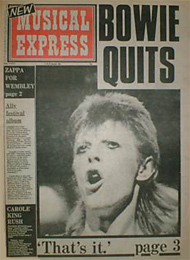
|
Once we open the studio all there will be left to do, is
just do it. I’ll be a great booster for me, a good kick in
the pants ya “know.” Lee’s first
solo album will probably be completely recorded on his own
in the studio. “I want to use the guitar as a basic and
then use multi-tracks and tricks and harmonies on top of
that. Possibly I might use somebody else, but mostly I
plan to just sit in the studio and record it myself. Still
it would be much looser than recording a normal album.
“Hopefully it’s going to be very different to anything
I’ve done before, that’s what I’m aiming at…to break out
of the conventional things I’ve been into – “It’s much
easier to do that on your own because you only have
yourself to argue with.
Despite
this spate of work, Alvin Lee insist the future of Ten
Years After is still healthy. Summing up, he said,
“ I just
want to see the band moving into another direction from
travelling around the world, playing the same thing all
the while. “To be honest, we could easily have just
carried on doing that. The concerts we play are all great
and we got fantastic receptions everywhere, but what’s
more important is what we feel inside ourselves and right
now we feel we should be going somewhere else.”
But does he
know exactly where?
“I was pretty mind blown when I heard
the Mahavishnu Orchestra recently, and perhaps that’s how
I’d like to see Ten Years After in a few years time…..but
I don’t know really, we’ve got to find our own natural
direction.”
|
|

From A German Album
Cover
|

New
Musical Express July 7, 1973 |
|

|
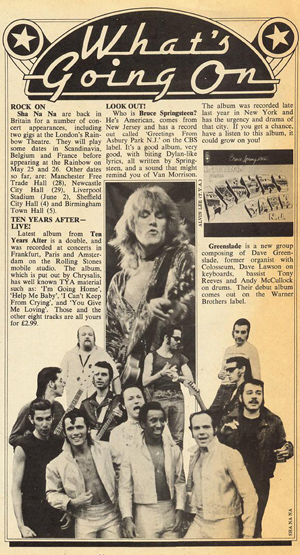
|
|
Recorded Live - Ten Years After

Chrysalis (VK 41049 / DIDX
4148)
Recorded in 1973 in various European locations, this album
was originally on two LP's and now makes it onto one midline
72 minute CD. That's a great bargain, especially when you
consider that the sound quality is pretty damn good (not as
radiant as you'd hope for, but pretty damn good).
Unfortunately, it's a rather dull album - was then, still is.
By 1973 Ten Years After had surpassed their performing peak,
and the group had long ago become little more than a showcase
for guitarist Alvin Lee's excesses, borne out here by two
eleven minute - plus tracks and one sixteen minute take on Al
Kooper's "I Can't Keep From Crying." That Lee was a
dynamic flash guitarist isn't in question, but that his
flashes don't quite work anymore is also true. Ten Years After
initially released this as a response to bootlegs
proliferating at the time, and one supposes it served its
purpose then. Today, you'd have to be a true loyalist to sit
through all seventy two minutes without a break or three.
Note: This article was written on 1/12/83 upon the release of
Recorded Live onto CD format for the very first time. The
American CD version says that due to time limitations of the
CD the song "Hobbit" had to be left off of the
finished product…while on the European release the entire
recording is intact - including "Hobbit".
Album Note: This album is a truthful recording of Ten Years
After with no overdubs or additives. What you hear is what
happened on the night. Recorded over four nights in Amsterdam,
Rotterdam, Frankfurt and Paris with the Rolling Stones mobile
recording truck and later mixed from sixteen track to stereo
at Olympic Studios in London. In answer to the inferior live
recordings sold illegally, this is the official Ten Years
After bootleg.
Produced by Ten Years After CD Preparation: Rhonda Shoen,
Sterling Sound, New York
Ten Years After: Live 2 LP Set Nadat ik de besprekingen
over de lp's "Ten Years After Recorded Live" had
gelezen heb ik de pen ter hand genomen. Ik ben niet zo weg van
Ten Years After, omdat ik niet zo van die Ellenlange
gitaarsolo's hou, maar ik heb toch de moeite genomen om deze
platen te beluisteren. Met als resultaat dat ik hem meteen
kocht.Wat re op deze lp's staat is het summum. Er staan
prachtige nummers op zoals het nummer: "Good Morning
Little Schoolgirl" en de prachtige drumsolo "Hobbit"
van Ric Lee. Bij het nummer "Help Me" zit een
geweldig ritme. En dan het nummer "I Can't Keep From
Cryin´Sometimes" wat heel mooi is met die bass-solo. En
"I'm Going Home" hoef ik niet eens te bespreken,
want iedere popliefhebber weet dat dit een geweldig numer is.
En ze hadden geen mooier afsluitingnummer kunnen geven als
"Choo-Choo Mama". Deze dubbel elpee had makkelijk 5
sterren kunnen halen. Ik heb maar van 1 ding spijt en dat is
dat ik hun optreden in Amsterdam of Rotterdam gemist heb. En
ik zal die andere lp's van "Ten Years After" eens
goed gaan beluisteren.
Afz. J. Tijsse Troelstrastraat 7 Breda P.S. Een recensie
schrijven is toch moeilijker dan ik dacht.
Ten Years After - Recorded Live July 17,
1973 - The Boston Phoenix Newspaper This Album is
long overdue. Most of the stars of Woodstock followed through
right away with live albums. But Ten Years After held back -
till now. Here are dazzling live performances of songs from
the first Ten Years After album to the most recent. Recorded
in front of rock and rollers in Paris, Frankfurt and Amsterdam
in Lee-o-phonic sound. $4.99 LP - $6.99 Tape
|
Ten
Years After – “Recorded Live” 1973
A
Two Record Set – Now On One CD Disk
Produced
By Ten Years After
Liner
Photo By: Brian Cooke
It
may not be one of the best live albums of all time, but
it’s in my personal top list. Along with: The
Rolling Stones “Get Your Ya Ya’s Out – The
Who “Live At Leeds” – Johnny Winter And!!!…Rush
“All The Worlds A Stage” – “Grand Funk Live”
– Deep Purple “Live In Japan” – Cactus
“Live” – Rainbow “Live”…. Judas Priest –
Black Sabbath – Cream Live and Humble Pie “Live At
The Fillmore” - The Allman Brothers "Live at the
Fillmore East".
Ten
Years After Live is an exceptionally good recording of
the band at their height.
In
the bands own words: “ In answer to the inferior live
recordings sold illegally, this is the official Ten
Years After bootleg”.
At
this point in time, the band was almost empty creatively,
and on the cusp of a major break up of the band. The
recordings on this cd are from a happy band riding high,
but coming down fast.
The
set list is their greatest hits performed live:
- One
Of These Days - 6:26
- You
Give Me Loving – 6:02
- Good
Morning Little School Girl – 7:35
- Help
Me – 11:06
- Choo-Choo-Mama
– 3:11
- I
Can’t Keep From Crying Sometimes – 15:57
- Slow
Blues In C – 7:52
- I’m
Going Home – 11:39
With
the others being:
9. Scat Thing - :54 seconds
10. The Hobbit (Drum Solo) – 7:15
11. Classical Thing - :55
My
Memory of 1973:
When
this album was released, it was the greatest thing back
then. A two record set, from my favourite band, it was
live, and the front cover photo suggested that the band
was very serious about the music they were making and
the lofty position of fame that they were in possession
of. This album got a lot of mileage – for me the
listener and for the band too.
The
band rode this album on yet another tour, and I wore out
one album after another in no time.
While
Ten Years After always did well in the recording studio,
it’s on stage where their magic comes alive a majority
of the time. Of course they had their off nights as
well, but this collection shows none of those cracks.
What you get is Ten Years After – nothing more and
nothing less. An actual accounting of what they were all
about and why they had such a loyal following, then and
now.
While
living in the States, I bought my copy of this recording
there when it was first released on CD format. To my
surprise I noticed that “The Hobbit” Ric Lee’s
drum solo was missing, reading on further it stated the
following: That due to time limitations, “Hobbit”
was excluded from this release. Now, I moved to Germany
in 2002 and found the same cd released here in Europe is
available with all the tracks, including the “Hobbit”.
Ten
Years After’s liner notes:
This
album is a faithful recording of Ten Years After with no
over dubs or additives. What you hear is what happened
on the night. Recorded over four nights in Amsterdam,
Rotterdam, Frankfurt and Paris with the Rolling Stones
recording truck and later mixed from sixteen track to
stereo at Olympic Studios in London.
In
Retrospect:
This was an excellent recording for its day. It
still holds up very well even now. But has since been
given a back seat to make room for Ten Years After -
“Live At The Fillmore East 1970”.
|
POP Magazine, No. 15 -
July 1973

|

TEN YEARS
AFTER performed August 3, 1973
|
NEW MUSICAL EXPRESS - July
21,
1973
Ten Years After: “Recorded Live”
 (Chrysalis) 1973 (Chrysalis) 1973
Considering the
number of bans that have split recently, it’s a wonder that
Ten Years After are still around. Because listening to this,
their first live album since their 1968 “Undead” album, it
becomes clear that Ten Years After have progressed very
little since the early days when the blues could be heard in
just about every club in Britain. Back then, Ten Years After
were one of the finest and even though a bit of flash, blues
bands around. If you don’t believe me, get a copy of
“Undead” and you’ll doubt no more. There was fire and
conviction in their playing, and they were a lot tighter,
never allowing the self-indulgence which becomes evident on
the sixteen minute plus version of, “I Can’t Keep From
Crying Sometimes” included here.
Alvin Lee’s guitar
does all its tricks, and say what you like, Lee is a good
guitarist, but it does get a little long. Unlike Cream, Ten
years After aren’t that much of an improvising band.
Alvin and bassist
Leo Lyons are really the only improvisers. In the past much
has been written about Lyon’s bass-playing, which just about
keeps pace with Alvin. It’s been said before, but Lyon’s is
one hell – of – a – dextrous bass player. Naturally enough,
“I’m Going Home”, (ain’t it about time he got there?) finds
its way onto this album and it’s not one of Lee’s best
versions. This album was recorded in Paris, Frankfurt and
Amsterdam, and Chrysalis are pushing it as “The Official Ten
Years After Bootleg” and at a cost of just three pounds,
it’s a good value if you want a record of what was one of
our finest blues bands.
Right now, Ten Years
After are in extreme danger of becoming stagnant.
Even Alvin Lee has
said he’s felt that way.
Article by Steve Clarke |

|
|
New Musical Express – August 11,
1973
(The Concert Was
August 3, 1973 and took place at Alexandra Palace –
North London Venue – called “ALLY – PALLY” for short)
 Friday – TYA / Wild
Turkey / Barclay James Harvest Friday – TYA / Wild
Turkey / Barclay James Harvest
I tell ya, the kids
still dig Alvin. They started arriving in the late afternoon,
and while Wild Turkey and Barclay James Harvest were good, the
evening belonged to Alvin Lee and Ten Years After. What better
way to spend a Friday night than with a few drinks and bit of
boogie. Getting into the festival spirit, kids came prepared
with blankets, wine and dope.
“Woodstock Nation”
lingers on. The fact that as many people turned out for Ten
Years After rock as for Black Sabbath’s satanical music, says
something for the youth of today. It warms the heart. Support
bands are having an easier time of it as the festival draws to
an end. The bigger the act, the larger the crowd and by the
time Wild Turkey played, the hall was almost full. I was
prepared to quite dislike the band, having seen them in
America last year where they impressed me as a very poor fifth
rate Jethro Tull imitation. Well, things have changed.
Wild Turkey are
by no means just another rock band, and Glen Cornick is
simply one of the band; no big ego trips here. While
their music leans heavily towards early Tull, Wild
Turkey are their own men. The same frantic instrumental
burst predominate yet are surrounded by melodic
passages. It’s music to listen to, nothing to bash heads
against the wall with. All hard driving stuff,
occasionally interspersed with a rhythmic acoustic
number. The slide guitar songs sound a bit like Wishbone
Ash in places, sweet, melodic rock. Tull similarities
come to a head on “Traffic Island Jam”, similar to
“Cat’s Squirrel” in parts. Everyone takes a solo in this
one. Bernie Marsden especially shines on a guitar solo
and we all know the merits of Mr. Cornick’s bass
playing. The audience gave the band a rousing reception
as half the crowd stood screaming for more by the set’s
end. They encored with “Butterfly” from their first
album. Make no mistake about it, “Wild Turkey” are going
to be BIG!Des Henley keeps
encouraging all to have a good bop and people seem more
than willing to rock out. Fumble are something no
festival should be without.
Next up were Barclay
James Harvest who offered amazing contrast to the evening’s
bill.How their orchestral
sounding music got on such a raunchy program is beyond me, yet
the crowd willingly listened. A strange lot, those Barclay’s.
When they’re good, the music is exciting as it is momentous.
Yet on occasion the songs tend to come off as muzak. However, Barclay aren’t as
staid as their mellotron cousins, The Moody Blues. Wholly
Wolstenholme joked about the bands recent failings in
finishing London sets. “We’re a bit nervous about getting
through the show”, wolly told the crowd. Barclay James Harvest
were the band rained on (or rained off) at White City. A tight
unit, the Barclays feed off each other musically. Every so
often, someone surprises with an amazing little chunk of
sound. John Lee’s moody guitar wanderings highly compliment
those sullen mellotron chords. The crowd were quite familiar
with the numbers instantly, recognising such Barclay standards
as “Mockingbird” and “She Said”. It’s a mystery why the band
haven’t yet happened in a bigger way. Their songs are original
and often lovely. Maybe the Moodie’s deluge of mellotron based
insights ruined the music buying public on bands of the same
calibre. Yet the Barclay’s carry on and on, always a welcome
addition to any concert bill.
A sense of
anticipation growing in the great hall, it was all down to Ten
Years After. Filled with thousands of rockers. Alvin had the
whole crowd in the palm of his hand. All he had to do was
deliver the same goods he’s been displaying for years, and the
evening was his.
So as soon as the man
announced Ten Years After, the whole of Ally Pally jumped to
their feet, letting out incredible shrieks of delight. Surging
forward, they madly applauded as the kid walked out on stage.
As steady as the rock of Gibraltar, Alvin played his axe.
Ten Years After are a
band to enjoy. Who really cares if they do the same things
they did years ago. Chuck Berry still plays the same material,
and it’s all good fun.
They’ve just got to be
the funniest, most enjoyable rock n´ roll band in the world.
Alvin all grimaces and lightning fast licks, Leo Lyons
plucking that bass and moving his body faster than the notes
he shoots out, Ric Lee the only percussionist with an ever
present grin on his face, and Chick Churchill over in the
keyboard corner occasionally stepping out and urging all to
clap along. And those kids down in front, staring at every
move Alvin makes, watching and waiting for every note he
plays. They did the old standards. There was Al Kooper’s “I
Can’t Keep From Crying Sometimes”, where in the middle of a
solo Alvin snuk in a few bars of “Sunshine Of Your Love”. The
man’s got a sense of humour. “Good Morning Little Schoolgirl”,
announced as a golden oldie´, featured the kid on punky
vocals. The lad sings a mean tune. Even in the back of the
hall where no one could see the stage, the fans loved it.
They loved it cause
Ten Years After know how to boogie, and they know how to
entertain. That’s why they’re so
damn enjoyable, and funny, that Alvin is a gas!
On the serious side,
Mr. Lee really is the guitar star we all want him to be.
Unfortunately that Woodstock aura still permeates the bands
image. Since Woodstock, the world has come to expect only one
thing from Ten Years After, and wherever they go, no one will
let them off the stage without playing that immortal song.

And, so it was at Ally Pally, that “Going Home” was finally
delivered with a firm injection of “Maybelline”, “Blue Suede
Shoes”, and “Whole Lotta Shakin´”. Quite lovely.
When it was over they
screamed out for more and yelled hooray as the band bounced
back on stage, to encore with “Sweet Little Sixteen”, and
“Choo-Choo-Mama” kept the pace alive right to the end.
Thanks for a swell
evening boys. Keep on choogling.
Article written by
Barbara Charone
|

CIRCUS
– MAGAZINE – AUGUST 1973
 Why
Alvin Lee Has To Get Beyond Ten Years After Why
Alvin Lee Has To Get Beyond Ten Years After
By
Barbara Graustark
Alvin
Lee’s Move To Save His Band – The Music Ten
Years After Couldn’t Make.
Even
while Alvin churned out the classic rockers the fans loved
for his new live LP, he was planning his first step away
from the six-year-old band. Alvin Lee: Ten Years After still
turn him on, but so do the rich, mellow chords and easy
country feel of gospel singer Mylon and the jazz-based tunes
of ex-King Crimson members, Ian Wallace, Mel Collins, and
Boz Burrell. Ten Years After: They claim Ten Years After
Recorded Live captures the essence of their choogling music.
But after eight LP’s, it’s hard to come up with new
material.
Blonde hair flying, bright lips turned downward into the
famous strained scowl, Alvin Lee bent further over his slim
guitar, hands picking furiously a song he had
played at least one thousand times before, “I Can’t Keep
From Crying Sometimes”. In the multitude of fans at the
Frankfurt, Germany, rock emporium the soulful blues-based
rhythms and heartfelt chanting struck a responsive chord.
Playing material from every Ten Years After album, from
their first, “Ten Years After”, to their last, “Rock
and Roll Music To The World”, Alvin, Chick, Ric and Leo
kept the crowds open mouthed with fascination as slick
fingered Alvin rolled out “I’m Going Home,” then broke
into “Scat Thing” with sharply toned vocals that jumped
the notes like a frightened deer.
Alvin
Steps Out:
But
even as a recording mobile unit was capturing what Alvin
would later describe as
“the essence
of Ten Years After’s music,” for a new Columbia record
album, to be known as “Ten Years After Recorded Live”
released in 1973. While rumours were spreading through the
British press that the classic oldies which pleased and
amazed the crowd were leaving the band less than totally
satisfied. And even while the new album was jumping up the
charts, Alvin was taking his first major steps away from Ten
Years After. His goal? Not to destroy Ten Years After, but
to save the floundering band by “broadening my horizons
musically,”
recording some very different music with some very different
musicians.
Making
The Social Scene:
The
decision to start jamming, Alvin says, crystallized about a
year ago, soon after he moved into his five-hundred year old
home in Oxfordshire, England. The manor house stood on the
edge of the Chilton hills surrounded by forest, and gave
Alvin both the privacy and the room to expand his interests.
For on the property, he noticed several outbuildings and a
big barn which he felt would be the perfect place to build
himself a recording studio.
The
decision was not a sudden one. For quite some time, Alvin
and Ten Years After had found it difficult to come up with
new material working under the strained confines and
financial pressures of a recording studio, “We need time
to experiment,” he revealed. “At
present we’ve always been hampered because you pay $80.00
for every hour you spend in the studio, and that doesn’t
give you the relaxed feeling you need for making music.
“There’s
a hope for the band that we’ll be able to get into some
new licks,” he explained.
And
Alvin himself was more than anxious to “get into a studio
and play for twelve hours a day.” But the new music he was
envisioning doesn’t stop with Ten Years After. The sixteen
track studio will also allow Alvin to record the material
he’s been writing and collecting in his three worn spiral
notebooks for over a year, the music Ten Years After
couldn’t make.
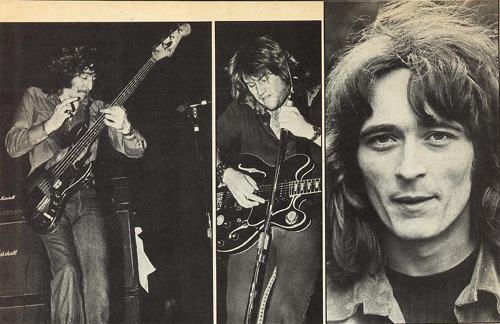
Guitar
– Oriented – Tunes:
When
Alvin slipped into the studio in June to begin recording his
solo album, he carried with him lyrics few of his group’s
members had ever heard. “Over the last few years I’ve
been writing a lot,” he admitted in his deep midland’s
drawl. “A lot that I’ve written hasn’t been suitable
for Ten Years After. It’s more influenced by the guitar.
Actually, it’s more of an outlet for me personally, rather
than the band. I’d like to get into my guitar thing.”
Alvin
was determined not to impose his own guitar-oriented style
on his band for fear of ruining Ten Years After’s own
unique style. “Ten Years After developed quite a strong
musical approach, an approach that’s great because it’s
free form. But in itself, this is a limitation. It’s loose
rock basically. On albums of the past, we have kind of
deviated from that style to try other things; but I don’t
know, it doesn’t seem right. And I figure Ten Years After
should do, what they do best.”

Mellowing
Out:
The
solo album, on the other hand, will contain overdubbed
material, with Alvin playing six different guitars, “which
on a Ten Years After album, would be overindulgence. I mean,
Ten Years After is a band, and I don’t want to lead it up
my own private path.” Carrying his acoustic Gretch guitar
and his tape recorder on the road through tours of America,
Europe and Japan, Alvin soon collected several volumes of
material that presented the lanky guitarist in a far
different light from his work with Ten Years After. The
sixty-odd tunes fell into varying styles, from “country
guitar licks, picking and all,” to sweet lyrical ballads.
Much of the material was “too mellow for Ten Years After.
I think it’s more mature from my point of view. I’m
probably digging around a lot more now. Ten Years After’s
stuff is pretty kind of “today I go away,” material.
Lyrics that are just words and don’t actually say a lot,
they’re sounds. When you rock and roll, you sing sounds,
you don’t sing lyrics.”
Words
That Mean Something:
Alvin
flipped open his notebook to read a few of the poems he
wants to convert into songs for the new album. One verse,
tentatively titled “There’s No Such Thing As The Top Of
The Hill,” barely hides its strong personal meaning:
There’s
no such thing as the top of the hill
-
I’ve
never been there again
There’s
no such thing as the top of the hill -
Unless
it’s in your brain
I’ve
done what I’m trying to do -
I’ve
seen what I hope to see
There’s
no such thing as the top of the hill
-
At
least there’s not for me.
“I
think realization influenced that verse,” he confided.
“Everybody has ambitions and when, in reality, you achieve
your ambitions and in retrospect you should be on top of the
world, you’re not, because there’s so much more to keep
doing.”
Struggle
For Fulfilment:
Some
tunes show Alvin’s persistent struggle for self-fulfilment,
the struggle that convinced him to try his hand at the solo
venture. Other tunes deal with concrete events, like the
feeling of “having your back up against the wall,” at
the start of an American tour. At times, lyrics dip into
mellow pools of despair and alienation. Alvin explained that,
“It’s not an idealistic world we live in. When you start
thinking in worthy terms, you often get depressed.”
Perhaps
his favourite tune, one he’s carried around for years, but
never been able to use, sounds his loneliest cry. Entitled
“Someday I Hope,” it begins:
Informed, transformed from what I was born – but
yet I search for truth – While the years chip away at my
youth, And I think, when I’m dead! Who will care what I
said – So I put down my pen and I go to bed…
Rolling
With Mylon:
To
insure that his words are remembered and his music continues
to echo in the ears of his fans, Alvin will pull another ace
from his sleeve. After the completion of his studio album,
he will return to the studio to begin another album, with
country-gospel rocker Mylon, who blew Alvin’s mind last
year when the Georgian singer first visited the Englishman
at his home.
Mylon,
Alvin, and Mylon’s guitarist, Steve Sanders journeyed down
to the home studio of “The Who’s” Roger Daltrey to lay
down several tracks which Alvin later claimed “blew my
mind,” and together with producer Allen Toussaint and ex-
Mountain bassist and producer Felix Pappalardi hope to
continue the work in late summer.
Once
Alvin shunned “superstar” jams that forced him to play
someone else’s style, or to convince them to play his.
Today he has found a group of musicians with whom he can
develop a “sympathy” that enables him to blend styles
with a newly-fired imagination.
But what of Ten Years After? Alvin seemed determined
that the band will continue, even if tours and LP releases
are stretched out to allow them all room to grow. “I say
we’ll never finish as
long as we go on playing good music,” he confirms.
“That’s the essence of what we do. There’s no reason
to stop making music.”
|
23
August 1973 - QUI giovani - Italy

Front Page

Page 46 & 47
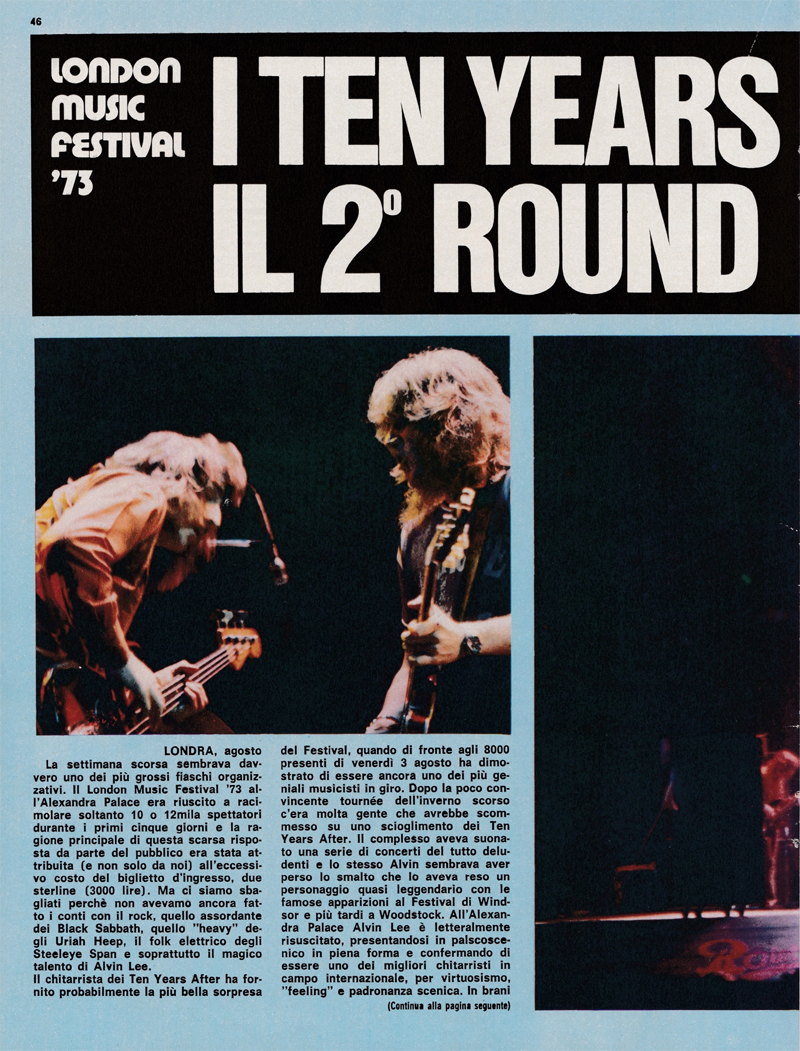




Record Mirror - August
25, 1973
| New
Musical Express - September 8, 1973
TYA TOUR – LEE –
CRIMSON LINK DENIED
Ten Years After
are to make their first British tour in almost a year.
The news of the 14 – day tour was announced by Chrysalis
this week and effectively puts paid to recent rumours
that the group were about to split up. The tour, which
opens at Plymouth Guildhall on September 15th,
is the first from the group this year, and is their
first British appearance since they headlined at the
Alexandra Palace Music Festival a month ago. Rumours
concerning the break up of the group began circulating
at the time of release of “Recorded Live”, the group’s
current album. Ten Years After stopped touring at that
time as both Alvin Lee and organist Chick Churchill had
begun work on solo projects. It was rumoured that Alvin
Lee was to leave the group and form a new band with
various musicians, namely ex- King Crimson members Mel
Collins and Boz Burrell who he had been playing with at
the recently-completed studio at Alvin’s home –
Space-Studios.
During the past
two months, Lee has been working constantly on an
album, recorded at his studio with American Gospel
singer Mylon LeFevre. The album consist entirely of new
songs written by Alvin and Mylon, with additional
material from star musicians who also made guest
appearances on the album. “I’m looking forward to going
on the road with Ten Years After again”, Alvin told New
Musical Express. “It’s going to be a tour on which we
can experiment, especially during the later part of the
tour, when we’ve got back into playing England again.
“Since we’ve been off the road during the last few
months, I’ve been working with Mylon who’s a gospel
singer from Georgia, and we’ve just about finished an
album
 together. It’s not my solo album, it’s the two of
us with some good people who came down to help. A solo
album is another project I have in mind for the future”.
Also at the mixing stage is a solo album from Ten Years After’s organist Chick Churchill. Both the Alvin Lee /
Mylon LeFevre album and the Chick Churchill album will
be released later this year. together. It’s not my solo album, it’s the two of
us with some good people who came down to help. A solo
album is another project I have in mind for the future”.
Also at the mixing stage is a solo album from Ten Years After’s organist Chick Churchill. Both the Alvin Lee /
Mylon LeFevre album and the Chick Churchill album will
be released later this year.
Dates finalized
so far for the Ten Years After tour are:
Plymouth Guildhall September 15th, Torquay
Town Hall 16th, Swansea Top Rank 17th,
Bristol Colston Hall 20th, Hastings Pier
Pavilion 22nd, Oxford New Theatre 30th,
Manchester Free Trade Hall October 3rd, Leeds
University 4th, Newcastle Mayfair 5th,
Edinburgh Heriot Watt University 6th,
Lancaster University 12th, York University 13th,
Wolverhampton Civic Hall 15th, and Glasgow
Apollo 19th. |
|

15
September 1973 - Tour Advertisement - New
Musical Express
Photo: Brian
Cooke

|
| EXKLUSIV BRAVO INTERVIEW
September 20, 1973 - NR. 39
Blass ausgepumpt, mit den Nerven am Ende erklärte Alvin
Lee Anfang 1973 bei der letzten Europa - Tournee: "Wir
hben die Nasse voll. Fünf Jahre sind genug. Ten Years After
wird es in Zukunft nicht mehr geben". Mit diesen drei
knappen Sätzen hatte der wortkarge Alvin Lee völlig
überraschend das Ende der explosivsten Blues Rock Band der
Welt verkündet.
Der Schock war perfekt. Bereits geplante Konzerte wurden
kurzfristig abgesagt. Die Band zerstreute sich in alle Winde.
Alvin Lee verkroch sich in sein eigenes Studio in Reading bei
London, Organist Chick Churchill bastelte an einer
Solo-Platte, Bassist Leo Lyons und Schlagzeuger Ric Lee
tauchten völlig unter. Man hatte sich Goodbye gesagt.
Sechs Monate später. Londoner Rock - Festival 1973 im
riesigen Alexandra Palace von den Fans liebevoll "Ally
Pally" genannt. In der engen Garderobe warten Ten Years
After auf ihren Auftritt. Kurzfristig hatten Alvin Lee &
Company ihren Namen auf die Plakate setzen lassen. Ein
Abschiedskonzert? Ein letzter Gag?
Im Alexandra Palace herrscht nervöse Spannung wie vor
einem Boxkampf. Auch hinter der Bühne. Kaum ein Wort fällt
als Alvin Lee und Leo Lyons ihre Gitarren stimmen. Sie sind
nervös. Niemand ahnt, was hinter ihren starren ,
konzentrierten Mienen vorgeht. Nur Ric Lee ist die Ruhe
selbst. Hingebungsvoll umwickelt er sein Trommelstöcke mit
rotem Klebestreifen, damit sie beim Auftritt nicht so leicht
brechen, Dann ist es soweit.
Ein frenetischer Jubelschrei, als Alvin Lee auf die Bühne
springt, etwas unsicher lächelt. Ein Meer von Händen reckt
sich ihm entgegen. Die 10,000 Fans kreischen so laut, dass Ten
Years After gar nicht anfangen können. Alvin Lee klatscht den
Takt vor, bis die ganze Halle mitmacht. Dann steigt er mit
" Rock n´ Roll Music To The World" ein. Ein
hämmernder Rock Orkan fegt von der Bühne. Ten Years After
spielen nicht nur Rock, sie zelebrieren ihn. Alvin Lees Finger
huschen so schnell über die Gitarre, dass man zehn Hände auf
einmal zu sehen glaubt. Faszinierend sein Gesicht. Zu jedem
Ton eine neue Grimasse. Völlig mitgerissen von seiner eigenen
Musik spitzt er die Lippen, bläst die Backen auf, schüttelt
seine blonde Mähne.

Leo Lyons scheint wie bei jedem Auftritt unter Strom zu
stehen. Er schüttelt seinen Körper immer wilder. Schneller
noch als die ekstatischen Bassläufe, die er seinem Instrument
entlockt. Chick Churchill scheint auf der Orgel Alvin Lee an
Schnelligkeit noch übertreffen zu wollen, Im Hintergrund, nur
von einem matten Spotlight beleuchtet, wütet er auf den
Tasten, treibt den Sound noch mehr an.
Wie in alten Zeiten thront Ric Lee grinsend auf seinem Podest
und tritt die Basstrommel, dass man es in der Magengrube
spürt. Nach, "Good Morning Little Schoolgirl" und
"Sunshine of Your Love" stampft ganz "Ally
Pally" mit. Und dann kommt der Song, der Ten Years After
in 9 Minuten und 20 Sekunden berühmt gemacht hat. Damals, bei
ihrem Auftritt zum legendären Woodstock-Rockfestival. Der
Song den Ten Years After seitdem bei jedem Konzert spielen
mussten, der ihre Visitenkarte wurde: "I'm Going Home".
Heute will es Alvin Lee wissen. Er streichelt und peitscht
seine Gitarre, stampft, klatscht, schreit, haucht. Immer
schneller, ohne Ende. Zehn, zwanzig, dreißig Minuten lang.
Dann ein donnernder Schlussakkord.
Ausgepumpt wie 100-Meter-Läufer lehnen Alvin, Leo, Ric und
Chick an ihren Verstärkerboxen, als der Beifall auf sie
niederprasselt. Jubel für eine Band, die es eigentlich nicht
mehr geben sollte. Jubel, der für Ten Years After an diesem
Abend mehr bedeutet als Beifall, Applaus.
In der Garderobe knallen wenige Minuten später die
Champagnerkorken. Spaßmacher Ric lässt ganze Fontänen durch
den Raum sprühen. Ich weiß nicht so recht, was hier
eigentlich passiert. Bis Alvin Lee sein Schweigen bricht.
Plötzlich packt er aus, sagt, was es mit diesem Konzert
eigentlich auf sich hatte...
"Dieser Auftritt entschied über die Zukunft von Ten
Years After, eigentlich war unsere Trennung schon besiegelt" , sagt
Alvin Lee, "kein Wunder, wenn man wie wir seit fünf
Jahren fast täglich auf der Bühne steht. Da kommt man sich
plötzlich vor wie eine Musicbox, die jeden Abend dieselbe
Platte spielt. Und das ist tödlich für jeden Musiker.
Deshalb wollten wir nach unserer letzten Live - Album Schluss
machen, unsere eigenen Wege gehen. Ein halbes Jahr ging das
gut. Dann juckte es uns wieder in den Fingern. Wir trafen uns
bei mir zu einigen Sessions. Und dann beschlossen wir, dieses
Konzert zu geben.
Wir wollten sehen, ob diese Musik uns und unseren Fans noch
Spaß macht. Allein davon machten wir unsere Entscheidung
abhängig..."
Ten Years After wird es also auch in Zukunft geben?
"Wir machen weiter", erklärt Alvin Lee, "etwas
anders allerdings als zuvor. Wir werden nicht mehr so viele
Live-Konzerte geben, weniger Platten zusammen produzieren.
Jeder soll die Freiheit haben, seine eigenen lnteressen zu
verwirklichen. Ich beispielsweise mache zur Zeit eine Platte
mit dem Gospelsänger Mylon Lefevre.
Chick hat ähnliches vor. Trotzdem werden wir jeden Monat
mindestens ein Konzert geben. Denn während unserer Funkstille
haben wir gemerkt, dass wir auf die Atmosphäre von
Live-Auftritten, auf die Feuerprobe vor den Fans, nicht
verzichten können..."
Written by - Gerald Büchelmaier
Fotos by - D.Zill
Contribution by John Tsagas
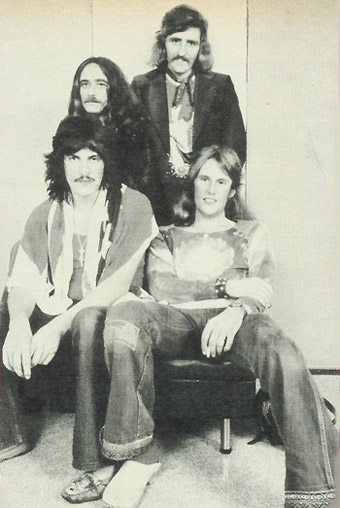


|

|
 |
Ten
Years After – Hastings Pier, White Rock, Hastings
Pier
– Pavilions England
On September 22, 1973 played a concert there. The
pier was originally opened in 1867, and is still struggling
today to remain open today. A temporary walkway has been
built over the now unsafe corridor boardwalk floor. Some
other bands of note who played there are: “The Who” –
“The Rolling Stones” – “The Spencer Davis Group”
– “Pink Floyd” – “Hawkwind” – “Status Quo”
– “Tom Jones” – “Golden Earring” – “Barclay
James Harvest” – “The Can” and of course, “Ten
Years After”.

|
|

Disaster strikes the famous “Hastings Pier” landmark
once again. Known as “The Peerless Pier” when it was
first built. On October 5, 2010 ten fire crews were sent
to the Victorian Structure in East Sussex, but the fire
was to fierce to save anything of the historic building.
Two teenagers aged 18 and 19 were placed under arrest on
suspicion of arson. The fire burned on for four days.
The famous pier first opened on August 5, 1872 and
closed in 2006 because of fears that it had become
unsafe. Although it had survived the Second World War,
The Mods and The Rockers, The Who, The Rolling Stones,
Jimi Hendrix and Ten Years After, It’s 138 year history
has now ended for good.



|
|
|
New Musical Express – October 6, 1973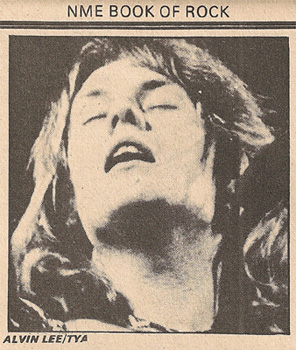
Book of Rock
– Page 72 (Revised by Dave)
Alvin Lee –
Vocals / Guitar / Harmonica / Songwriter
Leo Lyons – Bass
Guitar
Chick Churchill
– Keyboards / Organ / Piano / Moog
Ric Lee – Drums
/ Percussionist
Alvin and Leo
met in home-town Nottingham and played together in
Hamburg as the “Jaybirds” before being joined by Ric Lee
(no relation to Alvin), Chick Churchill was added on
keyboards and Ten Years After was now complete. They
emerged as one of the top bands of the Second Wave of
the British Blues Boom in 1966. Although they relied
more heavily on “rock” than on “authentic blues” like
their contemporaries, Peter Green’s Fleetwood Mac and
Chicken Shack. This ultimately led to a prestigious
residency at the Marquee and a spot on the Windsor Blues
Festival for Ten Years After, which drew a standing
ovation for the group.
By then they had
established a style all their own, and that they have
stuck close to ever since.
Which is
basically blues-based and fronted by the very speedy,
and accomplished guitarist Alvin Lee. After their
initial success in Britain, they made a big impact on
Europe and in the States. With the release of their
albums, so too the increase of their fan base, and with
the release of the movie Woodstock in 1970, it put them
over the top in popularity, fame and money. Both in
writing and playing, Alvin Lee came more to the
forefront of the band, and right into the title of
“Super-Star” and with it superstar status. He also gave
the majority of the interviews over the years, to anyone
who asked for one it seems.
It was also
their performance at Woodstock in 1969 that made their
tour-de-force song
“I’m going Home”
into the groups anthem, and was one of the most exciting
musical experiences in the entire film.
After extensive
touring, Alvin and the group took some much needed time
off between 1971 and 1972 to recover they indicated,
from “Woodstock Hangover”. They also wanted to make an
attempt at a more than straight rock record. To this
end, Ten Years After utilized electronic effects and a
much quieter approach to their music. The album went
gold and then platinum, with the hit song, “I’d Love To
Change The World” in the charts.
The music
critics, always at their heals suggested that the band
was in a “rut” – but their fans and audiences totally
disagreed with that unfounded assessment. Ten Years
After still proved to be a strong live attraction,
always better doing a live concert, than in the
recording studio.
The group got
off the road in the summer of 1973 good reasons. Chick
Churchill was working on his solo album “You and Me” –
Alvin Lee and Mylon LeFevre were working on their album
collaboration called – “On The Road To Freedom” and Leo
and Ric were working on other personal pet projects.
It should also be known, that Ten Years After have
undertaken more tours of the States than any other band
in the entire United Kingdom. |
|

New
Music Express
10 / 73
Ten
Years After
- Alvin
Lee, Leo Lyons, Ric Lee, Chick Churchill
Alvin
Lee and Leo Lyons met in home-town Nottingham, played
together in Hamburg before being joined
by
Ric Lee (no relation) to form Jaybirds. Chick
Churchill added later and name changed to Ten Years After.
Emerged
as one of top bands of second wave British blues boom
(1966) although drawing on “rock”.
More
heavily than “authentic” contemporaries like Fleetwood
Mac, Chicken Shack. Led to Marquee
Residency
and spot on Windsor Blues Festival which drew standing
ovation.
By
then had established style that they’ve stuck close to
ever since , basically blue-based and fronted by the
speedy
highly taut and accomplished guitar style of Alvin Lee.
After
initial success in Britain, made impact in Europe and
States with release of Undead and Stonedhenge,
The
quintessential eary TYA albums. Both in writing and
playing, Alvin Lee came more to the fore, being elevated to super-star status after band’s appearance at Woodstock
Festival in 1968. Their Goin’ Home
tour
de-force proved one of most exciting sequences in
subsequent movie.
After
extensive touring, took time off in 71 / 72 to cure
“Woodstock Hangover” and to make “A Space In Time”
an
attempt at more than a straight rock record. TYA utilised
electronic effects and a quieter approach. The
Album
was partially successful.

In
last few years critics have suggested TYA are in a rut,
but band still prove a strong live attraction, Undead
(1968)
and
Recorded Live (1973) give support to the view that they’re often better on stage than in studio. Went
off the road for six months through summer ’73, working
on solo projects. Alvin Lee has recorded album with
Gospel
singer Mylon; Chick Churchill also has solo LP upcoming.
TYA
have distinction of undertaking more U.S. tours than any
other British band.
|

New Musical
Express October 13, 1973 |

|
|
 |
|

|
Friday
October 19, 1973
Ten
Years After at the Glasgow Apollo,
Scotland’s premier rock
venue.
 |

|
| New
Musical Express – October 20, 1973

Alvin Lee is
quite traditional-minded really.
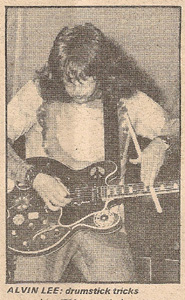 Despite Woodstock, despite a Georgian mansion, he’s still something of a Midlander who sticks to the basic ideas about music he’s
worked by all along. In many ways Lee’s philosophy is
one of the late sixties. He doesn’t believe theatricals
have any place in rock music. He doesn’t feel issuing a
single is a valid musical exercise. Maybe it’s his
shades of conservatism that have caused Ten Years After
to suffer in the last couple of years. Really, there are
two ways looking at the band. There’s no doubt they
still excel in straight ahead rock for undemanding
taste. Yet now perhaps, it’s not unfair to expect
something more creative from a band of their stature.
Certainly, one feels, in their hearts, even Ten Years
After themselves feel their particular style is in
danger of becoming redundant. After coming off-stage at
the Manchester Free Trade Hall a couple of weeks back,
Alvin Lee was comparing the quality of two guitars. One,
his normal red Gibson, the other, a different one he
used for the show in Manchester. Over in the opposite
corner, Leo Lyons rubbed his face with a towel and
flashed a self-conscious smile. “So you see, we change
our instruments if not our material”. It simply goes to
show Ten Years After have been criticised so much for
playing the same set that they even make modest jokes
about it themselves. Despite Woodstock, despite a Georgian mansion, he’s still something of a Midlander who sticks to the basic ideas about music he’s
worked by all along. In many ways Lee’s philosophy is
one of the late sixties. He doesn’t believe theatricals
have any place in rock music. He doesn’t feel issuing a
single is a valid musical exercise. Maybe it’s his
shades of conservatism that have caused Ten Years After
to suffer in the last couple of years. Really, there are
two ways looking at the band. There’s no doubt they
still excel in straight ahead rock for undemanding
taste. Yet now perhaps, it’s not unfair to expect
something more creative from a band of their stature.
Certainly, one feels, in their hearts, even Ten Years
After themselves feel their particular style is in
danger of becoming redundant. After coming off-stage at
the Manchester Free Trade Hall a couple of weeks back,
Alvin Lee was comparing the quality of two guitars. One,
his normal red Gibson, the other, a different one he
used for the show in Manchester. Over in the opposite
corner, Leo Lyons rubbed his face with a towel and
flashed a self-conscious smile. “So you see, we change
our instruments if not our material”. It simply goes to
show Ten Years After have been criticised so much for
playing the same set that they even make modest jokes
about it themselves.
One went up to
Manchester to review Ten Years After on their current
tour, but found there wasn’t anything new to review.
What they played sounded fine, but over-familiar. It was
like the band had appeared out of a late sixties time
capsule, still preserving with,
“Good Morning
Little Schoolgirl” and “Going Home”, which Alvin must
now be able to play in his sleep. As a guitarist, he
pulled out all his gymnastic tricks, including rapping
the guitar strings with drum stick provided by Ric Lee
drum kit, and there’s Alvin rubbing his guitar strings
against the microphone stand.
Still, as the
band ostensibly took a five month break over the summer,
to work on new ideas with the hope of pulling the band
out of a routine that was beginning to sound as tired as
an old Hollywood musical. It’s reasonable to ask why
nothing had changed. Alvin Lee himself has always
defended the old material like “Goin´ Home”, pointing
out that it’s what a
Ten Years After
audience still want to hear. Never the less, drummer Ric
Lee helps put the situation in perspective: “I think
there’s no doubt that we’ve been in a rut, and that’s
one reason why we took some time off. But I don’t think
any results will show until after this tour, when we
rehearse and put in some new numbers together for the
new album. “Remember, after Woodstock we did the same
thing, and went off the road for awhile, to get out of
the standard rock material, that we’d been into. Then we
came up with the “A Space In Time” album, which I think
was recognized as one of our best.
One of the more
positive results, though, of Ten Years After’s spell off
the road has been Alvin Lee’s album with Mylon LeFevre,
which is due for release next month and was recorded in
Alvin’s home studios. Mylon and Alvin were aided by,
among others, Stevie Winwood and for just one track,
(the song “So Sad”) by George Harrison, a close
neighbour of Alvin’s. “Mylon and I just met him at the
local (Speakeasy) says Alvin. “Mylon just went up to him
and asked him to write a song for the album. He came up
with “So Sad” and then came over and played on it as
well. “In fact, he’s got a great studio himself”,
continues Alvin incidentally. “I’ve been over there to
play some tapes in the last few weeks, and he’s got it
decked out like a living room Victorian studio and with
mahogany walls and a teak control desk”. Still despite
Alvin’s solo accomplishments, and the future of Ten
Years After, still hangs in the balance. Whether they
become cast as a stagnant relics of the sixties, now all
depends on the results of their next album.
Article by James Johnson |









TYA backstage 1972 - Photos
Courtesy of Pieter Kentrop

|

|
BRAVO Magazine
November 8, 1973

|
|
|
1973
- Music Life Magazine, Japan

lyrics "I'd Love
To Change The World / The World Is Changing"

above and below: Alvin Lee
with Gibson ES 345 Sunburst - Photos taken in Autumn
1970


Alvin Lee Face To Face


Photo most likely taken in March
1971

Photo taken between November 1972
and January 1973

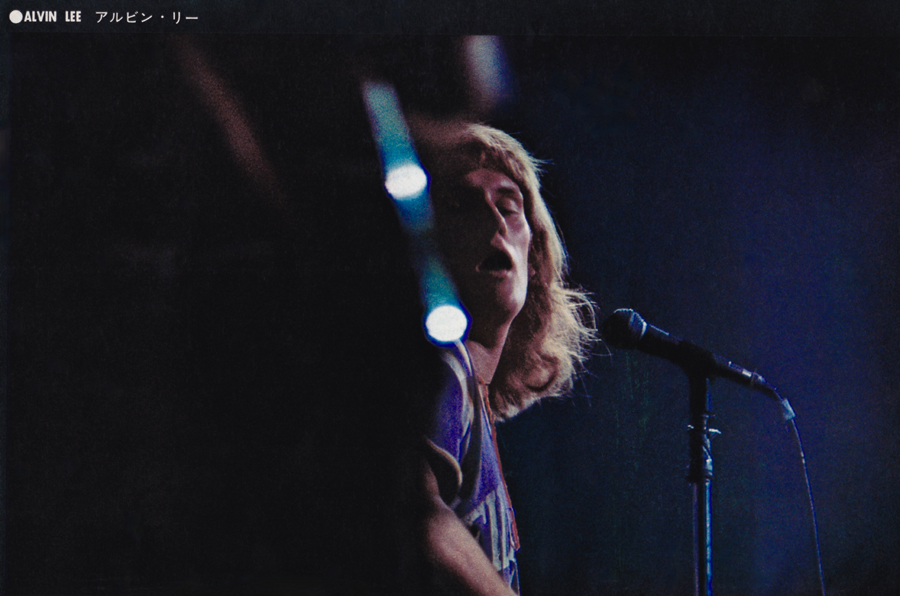
Photo taken in Autumn 1970

History of Alvin Lee

On Stage

Photo taken at Reading Festival,
13 August 1972

Leo Lyons / Chick
Churchill

Ric Lee / Alvin Lee
|
December 1973 -
POP Magazine, No. 24 - Switzerland & Germany

POP Magazine, No. 25
- Big Size Poster, December 1973

Contribution by Marcel Aeby
|